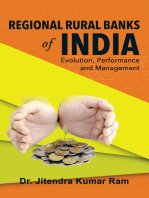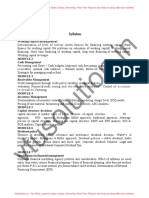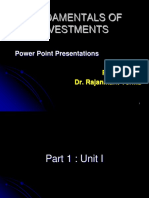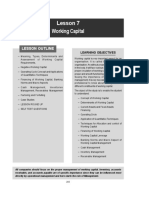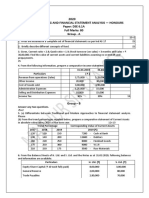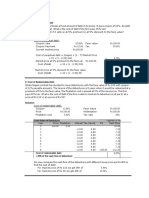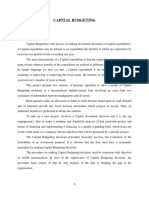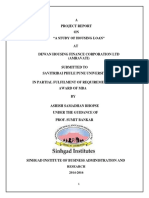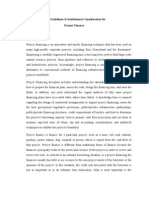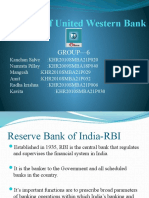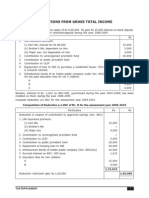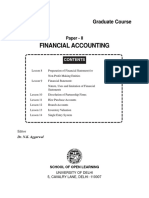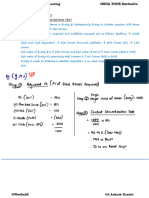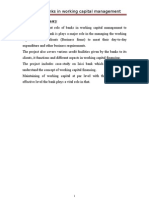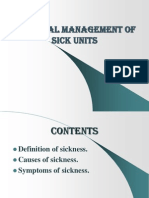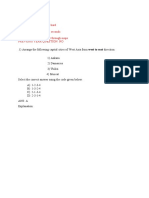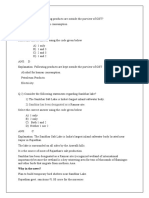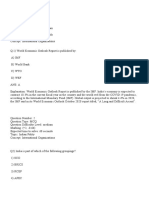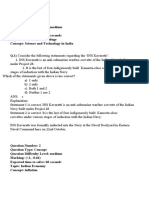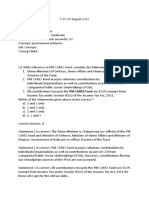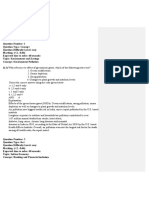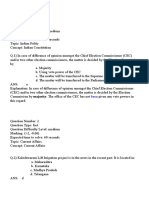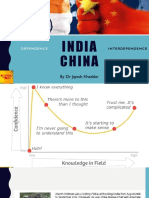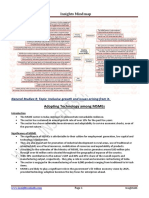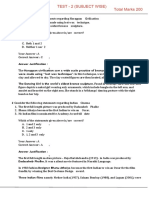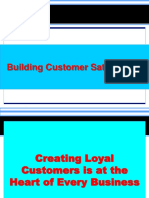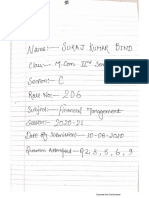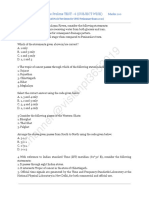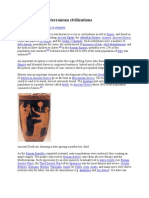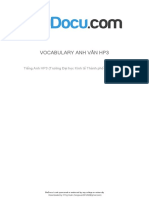Management-of-Working-Capital-Notes SAU
Management-of-Working-Capital-Notes SAU
Uploaded by
Saurav MedhiCopyright:
Available Formats
Management-of-Working-Capital-Notes SAU
Management-of-Working-Capital-Notes SAU
Uploaded by
Saurav MedhiOriginal Description:
Copyright
Available Formats
Share this document
Did you find this document useful?
Is this content inappropriate?
Copyright:
Available Formats
Management-of-Working-Capital-Notes SAU
Management-of-Working-Capital-Notes SAU
Uploaded by
Saurav MedhiCopyright:
Available Formats
CA Inter FM-ECO CA Mayank Kothari
Chapter 11
Management of Working Capital
Unit I: Introduction to Working Capital Management
Q1. Explain the meaning of the term “Working Capital”. Also give its formula.
Answer:
In accounting term working capital is the difference between the current
assets and current liabilities.
If we break down the components of working capital we will found
working capital as follows:
Working Capital = Current Assets − Current Liabilities
Q2. Mention the different situations when an asset is classified as current and
when a liability is classified as current liability.
Answer:
An asset is classified as current asset in the following situations:
i. It is expected to be realized or intends to be sold or consumed in normal
operating cycle of the entity.
ii. The asset is primarily held for the purpose of trading.
iii. It is expected to be realized within 12 months after the reporting period.
iv. It is non-restricted cash or cash-equivalent.
Whereas, a liability is classified as current liability in the following situations:
i. It is expected to be settled in normal operating cycle of the entity.
ii. The liability is held primarily for the purpose of trading.
iii. It is expected to be settled within twelve months after the reporting
period.
Page 1 of 104
CA Inter FM ECO Video Lectures available at www.Caconnect.in
Management of Working Capital
Q3. Mention the different categories into which current assets and current
liabilities can be grouped for the purpose of working capital management.
Answer:
The current assets of an entity, for the purpose of working capital management can
be grouped into the following main heads:
a. Inventory (raw material, work in process and finished goods)
b. Receivables (trade receivables and bills receivables)
c. Cash or cash equivalents (short-term marketable securities)
d. Prepaid expenses
On the other hand current liabilities of an entity, for the purpose of working capital
management can be grouped into the following main heads:
a. Payable (trade payables and bills receivables)
b. Outstanding payments (wages & salary etc.)
Q4. The concept of working Capital can be explained through different angles.
Depict them in a pictorial format.
Answer:
Working Capital
On the basis of Value On the basis of Time
Gross Net Permanent Fluctuating
Page 2 of 104
CA Inter FM ECO Video Lectures available at www.Caconnect.in
CA Inter FM-ECO CA Mayank Kothari
Q5. Explain the concept of working Capital from the point of view of value.
Answer:
From the value point of view, Working Capital can be defined as Gross
Working Capital or Net Working Capital.
Gross working capital refers to the firm’s investment in current assets.
Net working capital refers to the difference between current assets and
current liabilities.
A positive working capital indicates the company’s ability to pay its short-
term liabilities.
On the other hand a negative working capital shows inability of an entity
to meet its short-term liabilities.
Q6. Explain the concept of working Capital from the point of view of time.
Answer:
From the point of view of time, working capital can be divided into two
categories viz., Permanent and Fluctuating (temporary).
Permanent working capital:
It refers to the base working capital, which is the minimum level of
investment in the current assets that is carried by the entity at all
times to carry its day to day activities.
Temporary working capital:
It refers to that part of total working capital, which is required by an
entity in addition to the permanent working capital.
It is also called variable working capital which is used to finance the
short term working capital requirements which arises due to
fluctuation in sales volume.
Both kind of working capital, i.e. permanent and fluctuating (temporary)
are necessary to facilitate production and sales through the operating
cycle.
Page 3 of 104
CA Inter FM ECO Video Lectures available at www.Caconnect.in
Management of Working Capital
Q7. What will happen when the company has working capital, other than
optimum level (that is, large working capital and inadequate working
capital)?
Answer:
Management of working capital is an essential task of the finance
manager. He has to ensure that the amount of working capital available
with his concern is neither too large nor too small for its requirements.
Large working capital:
A large amount of working capital would mean that the company has
idle funds.
Also, large working capital results in over capitalization.
Over capitalization implies that a company has too large funds for its
requirements.
Since funds have a cost, the company has to pay huge amount as
interest on such funds.
This result in a low rate of return, a situation which implies a less
than optimal use of resources.
Inadequate Working Capital:
If the firm has inadequate working capital, such firm runs the risk of
insolvency.
Paucity of working capital may lead to a situation where the firm may
not be able to meet its liabilities.
Page 4 of 104
CA Inter FM ECO Video Lectures available at www.Caconnect.in
CA Inter FM-ECO CA Mayank Kothari
Q8. Explain why is it essential to maintain working capital in short term as well
as long term?
Answer:
Maintaining adequate working capital is not just important in the short-
term but in the long- term as well.
When businesses make investment decisions they must not only
consider the financial outlay involved with acquiring the new machine or
the new building, etc., but must also take account of the additional
current assets that are usually required with any expansion of activity.
For e.g.:-
Increased production leads to holding of additional stocks of raw
materials and work-in-progress.
An increased sale usually means that the level of debtors will
increase.
A general increase in the firm’s scale of operations tends to imply a
need for greater levels of working capital.
Q9. What are the different indicators of working capital situation? Mention the
optimum level of those indicators.
Answer:
Current ratio (current assets/current liabilities) (along with acid test ratio
to supplement it) has traditionally been considered the best indicator of
the working capital situation.
It is understood that a current ratio of 2 (two) for a manufacturing firm
implies that the firm has an optimum amount of working capital.
This is supplemented by Acid Test Ratio (Quick assets/Current liabilities)
which should be at least 1.
Thus it is considered that there is a comfortable liquidity position if liquid
current assets are equal to current liabilities.
As a thumb rule, this may be quite adequate.
Page 5 of 104
CA Inter FM ECO Video Lectures available at www.Caconnect.in
Management of Working Capital
However, it should be remembered that optimum working capital can
be determined only with reference to the particular circumstances of a
specific situation.
In nutshell, a firm should have adequate working capital to run its
business operations.
Both excessive as well as inadequate working capital positions are
dangerous
Q10. Mention the different functions with which working capital management
is primarily concerned.
Answer:
Working capital management is primarily concerned with the following
functions:
a) Maintaining adequate working capital (management of the level
of individual current assets and the current liabilities) or,
Investment in working capital and
b) Financing of the working capital.
Investment in working capital is concerned with the level of investment
in the current assets. It gives the answer of ‘How much’ fund to be tied
in to achieve the organization objectives (i.e. Effectiveness of fund).
Financing decision concerned with the arrangement of funds to finance
the working capital. It gives the answer ‘Where from’ fund to be
sourced’ at lowest cost as possible (i.e. Economy).
Q11. Briefly explain the entire exercise of working capital management.
Answer:
For maintaining adequate working capital, Finance Manager needs to
plan and compute the working capital requirement for its business.
Sound financial and statistical techniques, supported by judgment
should be used to predict the quantum of working capital required at
different times.
And once the requirement has been computed he needs to ensure that
it is financed properly.
Page 6 of 104
CA Inter FM ECO Video Lectures available at www.Caconnect.in
CA Inter FM-ECO CA Mayank Kothari
This whole exercise is nothing but Working Capital Management.
Q12. Mention the factors which need to be considered while planning for
working capital requirement.
Or,
What are the different components/determinants of working capital?
Briefly explain them.
Answer:
The following factors need to be considered while planning for working capital
requirement:
1. Cash –
Identify the cash balance which allows for the business to meet
day-to- day expenses, but reduces cash holding costs.
2. Inventory –
Identify the level of inventory which allows for uninterrupted
production but reduces the investment in raw materials and hence
increases cash flow.
For this techniques like Just in Time (JIT) and Economic order
quantity (EOQ) are used.
3. Receivables –
Identify the appropriate credit policy, i.e., credit terms which will
attract customers, such that any impact on cash flows and the cash
conversion cycle will be offset by increased revenue and hence
Return on Capital (or vice versa).
The tools like Discounts and allowances are used for this.
4. Short-term Financing Options –
Inventory is ideally financed by credit granted by the supplier;
dependent on the cash conversion cycle.
It may however, be necessary to utilize a bank loan (or overdraft),
or to “convert debtors to cash” through “factoring” in order to
finance working capital requirements.
5. Nature of Business –
For e.g. in a business of restaurant, most of the sales are in Cash.
Page 7 of 104
CA Inter FM ECO Video Lectures available at www.Caconnect.in
Management of Working Capital
Therefore need for working capital is very less.
6. Market and Demand Conditions –
For e.g. if an item’s demand far exceeds its production, the
working capital requirement would be less as investment in
finished goods inventory would be very less.
7. Technology and Manufacturing Policies –
For e.g. in some businesses the demand for goods is seasonal, in
that case a business may follow a policy for steady production
through out over the whole year or instead may chose policy of
production only during the demand season.
8. Operating Efficiency –
A company can reduce the working capital requirement by
eliminating waste, improving coordination etc.
9. Price Level Changes –
For e.g. rising prices necessitate the use of more funds for
maintaining an existing level of activity.
For the same level of current assets, higher cash outlays are
required.
Therefore the effect of rising prices is that a higher amount of
working capital is required.
Q13. Management of working capital involves 3Es. Mention them
Answer:
The management of working capital involves 3Es, which have been mentioned as
below:
i. Economy
ii. Efficiency
iii. Effectiveness
Page 8 of 104
CA Inter FM ECO Video Lectures available at www.Caconnect.in
CA Inter FM-ECO CA Mayank Kothari
Q14. How can we group the scope of working capital management?
Answer:
The scope of working capital management can be grouped into two broad areas:
i. Profitability and Liquidity
ii. Investment and Financing Decision
Q15. Briefly explain Profitability and Liquidity as a scope of working capital
management. Also explain why a trade-off is necessary between liquidity
and profitability.
Answer:
For uninterrupted and smooth functioning of the day to day business
of an entity it is important to maintain liquidity of funds evenly.
Also we know that each rupee of capital bears some cost. So, while
maintaining liquidity the cost aspect needs to be borne in mind.
Unnecessary tying up funds in idle assets not only reduces the liquidity
but also reduces the opportunity to earn better return from a
productive asset.
Hence, a trade-off is required between the liquidity and profitability
which increases the profitability without disturbing the day to day
functioning.
This requires 3Es, i.e. economy in financing, efficiency in utilization and
effectiveness in achieving the intended objectives.
Page 9 of 104
CA Inter FM ECO Video Lectures available at www.Caconnect.in
Management of Working Capital
Q16. Summarize and present in a tabular format, the advantages of profitability
and liquidity, with respect to the components of working capital. Also
present in the same table the trade-off between profitability and liquidity.
Answer:
Components of Advantages of Trade-off (between Advantages of
Working Capital higher side Profitability and lower side
(Profitability) Liquidity) (Liquidity)
Inventory Fewer stock-outs Use techniques like Lower inventory
increase the EOQ, JIT etc. to requires less
profitability carry optimum level capital but
of inventory. endangered stock-
out and loss of
goodwill.
Receivables Higher credit Evaluate the credit Cash sales provide
period attract policy; use the liquidity but fails
customers and services of debt to boost sales and
increase revenue management revenue
(factoring) agencies
Pre-payment of Reduces Cost-Benefit Improves or
Expenses uncertainty and analysis required maintains liquidity
profitability in
inflationary
environment
Cash and Cash Payables are Cash budgets and Cash can be
Equivalents honoured in time, other cash invested in some
improves the management other investment
goodwill and techniques can be avenues
helpful in getting used
future discounts.
Payables and Capital can be used Evaluate the credit Payables are
Expenses in some other policy and related honoured in time,
investment cost improves the
avenues goodwill and
helpful in getting
future discounts
Page 10 of 104
CA Inter FM ECO Video Lectures available at www.Caconnect.in
CA Inter FM-ECO CA Mayank Kothari
Q17. How will a company decide how much amount is required to be invested
in current assets as working capital?
Answer:
How much amount is required to be invested in current assets as
working capital is a matter of policy decision by an entity.
It has to be decided in the light of organizational objectives, trade
policies and financial (cost-benefit) considerations.
There is not set rules for deciding the level of investment in working
capital.
Some organizations due to its peculiarity require more investment than
others.
For example:
An infrastructure development company requires more
investment in its working capital as there may be huge inventory in
the form of work in progress
While, on the other hand a company which is engaged in fast food
business, comparatively requires less investment.
Q18. The amount which is required to be invested in current assets as working
capital depends on various factors. Mention and briefly explain those
factors.
Answer:
The level of investment depends on the various factors listed below:
a. Nature of Industry:
Construction companies, breweries etc. requires large investment in
working capital due to long gestation period.
b. Types of products:
Consumer durable has large inventory as compared to perishable
products.
c. Manufacturing vs. Trading vs. Service:
A manufacturing entity has to maintain three levels of inventory i.e.
raw material, work-in-process and finished goods whereas a trading
Page 11 of 104
CA Inter FM ECO Video Lectures available at www.Caconnect.in
Management of Working Capital
and a service entity has to maintain inventory only in the form of
trading stock and consumables respectively.
d. Volume of sales:
Where the sales are high, there is a possibility of high receivables as
well.
e. Credit policy:
An entity whose credit policy is liberal has not only high level of
receivables but requires more capital to fund raw material purchases.
Q19. Working capital decisions are categorized into 3 approaches, based on the
organizational policy and risk-return trade-off. Briefly explain those
approaches.
Answer:
Based on the organizational policy and risk-return trade off, working capital
investment decisions are categorized into the following three approaches:
a. Aggressive:
Here investment in working capital is kept at minimal investment
in current assets which means the entity does hold lower level of
inventory, follow strict credit policy, keeps less cash balance etc.
The advantage of this approach is that - lower level of fund is tied
in the working capital which results in lower financial costs
But the flip side could - be that the organization could not grow
which leads to lower utilization of fixed assets and long term
debts.
In the long run firm stay behind the competitors.
b. Conservative:
In this approach, organizations invest high capital in current
assets.
Organisations also keep inventory level higher, follows liberal
credit policies, and cash balance as high as to meet any current
liabilities immediately.
Page 12 of 104
CA Inter FM ECO Video Lectures available at www.Caconnect.in
CA Inter FM-ECO CA Mayank Kothari
The advantage of this approach are - higher sales volume,
increased demand due to liberal credit policy and increase
goodwill among the suppliers due to payment in short time.
The disadvantages are –
Increase cost of capital,
Higher risk of bad debt, and
Shortage of liquidity in long run to longer operating cycles.
c. Moderate:
This approach is in between the above two approaches.
Under this approach a balance between the risk and return is
maintained to gain more by using the funds in very efficient
manner.
Q20. Briefly explain Current Assets to Fixed Assets Ratio.
Answer:
Dividing current assets by fixed assets gives current assets/fixed assets
ratio.
A firm needs fixed and current assets to support a particular level of
output.
As the firm’s output and sales increases, the need for current assets
also increases.
Generally, current assets do not increase in direct proportion to output;
current assets may increase at a decreasing rate with output.
As the output increases, the firm starts using its current asset more
efficiently.
The level of the current assets can be measured by creating a
relationship between current assets and fixed assets.
Page 13 of 104
CA Inter FM ECO Video Lectures available at www.Caconnect.in
Management of Working Capital
Q21. Explain how Current Assets to Fixed Assets Ratio indicate conservative
current assets policy and aggressive current assets policy.
Answer:
Dividing current assets by fixed assets gives current assets/fixed assets
ratio.
Assuming a constant level of fixed assets,
A higher current assets/fixed assets ratio indicates a conservative
current assets policy and
A lower current assets/fixed assets ratio means an aggressive
current assets policy assuming all factors to be constant.
A conservative policy implies greater liquidity and lower risk whereas
an aggressive policy indicates poor liquidity and higher risk.
Moderate current assets policy will fall in the middle of conservative
and aggressive policies.
The current assets policy of most of the firms may fall between these
two extreme policies.
Q22. Operating cycle is one of the most reliable methods of estimating working
capital needs of an organization. However there are other different
methods too which can be used in estimating working capital needs.
Briefly explain those methods.
Answer:
Operating cycle is one of the most reliable methods for computation of Working
Capital. However, other methods like ratio of sales and ratio of fixed investment
may also be used to determine the Working Capital requirements, which have been
explained below:
i. Current Assets Holding Period:
To estimate working capital needs based on the average holding
period of current assets and relating them to costs based on the
company’s experience in the previous year.
This method is essentially based on the Operating Cycle Concept.
ii. Ratio of Sales:
Page 14 of 104
CA Inter FM ECO Video Lectures available at www.Caconnect.in
CA Inter FM-ECO CA Mayank Kothari
To estimate working capital needs as a ratio of sales on the
assumption that current assets change with changes in sales.
iii. Ratio of Fixed Investments:
To estimate Working Capital requirements as a percentage of fixed
investments.
Q23. There are a number of factors which have an impact on choosing the
method to be used in estimating working capital. Write a short note on
such factors.
Or,
Mention the different factors that must be given due weightage in
projecting working capital requirements.
Answer:
A number of factors impact the choice of method used in estimating
Working Capital.
Factors such as seasonal fluctuations, accurate sales forecast,
investment cost and variability in sales price would generally be
considered.
The production cycle and credit and collection policies of the firm also
have an impact on Working Capital requirements.
Therefore, they should be given due weightage in projecting Working
Capital requirements.
Q24. Briefly explain the meaning of “operating or working capital cycle” used as
a tool for managing working capital. Also explain its calculations.
Answer:
The operating cycle analyzes the accounts receivable, inventory and
accounts payable cycles in terms of number of days.
For example:
Accounts receivables are analyzed by the average number of days
it takes to collect an account.
Page 15 of 104
CA Inter FM ECO Video Lectures available at www.Caconnect.in
Management of Working Capital
Inventory is analyzed by the average number of days it takes to turn
over the sale of a product (from the point it comes in the store to
the point it is converted to cash or an account receivable).
Accounts payables are analyzed by the average number of days it
takes to pay a supplier invoice.
Operating/Working Capital Cycle Definition:
Working Capital cycle indicates the length of time between a
company’s paying for materials, entering into stock and receiving the
cash from sales of finished goods. It can be determined by adding the
number of days required for each stage in the cycle.
In the form of an equation, the operating cycle process can be
expressed as follows:
Operating cycle = R + W + F + D − C
Where,
R = Raw material storage period
W = Work-in-progress holding period
F = Finished goods storage period
D = Receivables (Debtors) collection period
C = Credit period allowed by suppliers (Creditors)
Q25. Briefly explain why working capital financing is needed.
Answer:
The faster a business expands the more cash it will need for working
capital and investment.
Good management of working capital will generate cash which will help
improve profits and reduce risks.
Most businesses cannot finance the operating cycle (accounts
receivable days + inventory days) with accounts payable financing
alone.
Consequently, working capital financing is needed.
This shortfall is typically covered by the net profits generated internally
or by externally borrowed funds or by a combination of the two.
Page 16 of 104
CA Inter FM ECO Video Lectures available at www.Caconnect.in
CA Inter FM-ECO CA Mayank Kothari
It is important to bear in mind that the cost of providing credit to
customers and holding stocks can represent a substantial proportion of
a firm’s total profits.
Q26. What are the different dimensions of the component of working capital?
Answer:
Each component of working capital (namely inventory, receivables and
payables) has two dimensions:
TIME, and
MONEY,
And when it comes to managing working capital then time is money.
Q27. Mention the different situations where we can get money to move faster
or slower around the operating/working capital cycle. What will happen
when we can move money faster around the operating/ working capital
cycle?
Answer:
The different situations where we can get money to move faster or
slower around the operating/working capital cycle are mentioned as
below:
If you….. Then…..
Collect receivables (debtors) faster You release cash from the cycle
Collect receivables (debtors) slower Your receivables soak up cash
Get better credit (in terms of You increase your cash
duration or amount) from suppliers resources
Shift inventory (stocks) faster You free up cash
Move inventory (stocks slower) You consume more cash
If you can get money to move faster around the cycle (e.g. collect
monies due from debtors more quickly) or reduce the amount of
money tied up (e.g. reduce inventory levels relative to sales), the
business will generate more cash or it will need to borrow less money
to fund working capital.
Page 17 of 104
CA Inter FM ECO Video Lectures available at www.Caconnect.in
Management of Working Capital
Similarly, if you can negotiate improved terms with suppliers e.g. get
longer credit or an increased credit limit; you are effectively creating
free finance to help fund future sales.
Q28. The determination of operating cycle indicates a number of things with
respect to a company. Mention them.
Answer:
The determination of operating capital cycle helps in the forecast,
control and management of working capital.
The length of operating cycle is the indicator of performance of
management.
The net operating cycle represents the time interval for which the firm
has to negotiate for Working Capital from its bankers.
It enables to determine accurately the amount of working capital
needed for the continuous operation of business activities.
The duration of working capital cycle may vary depending on the nature
of the business.
Q29. How will you calculate the different components of working capital?
Answer:
The different components of working capital maybe computed as follows:
(1) Raw Material Average stock of raw material
=
Storage Period Average Cost of Raw Material Consumption per day
(2) Work-in-progress Average Work − in − progress inventory
=
holding period Average Cost of Production per day
(3) Finished goods Average stock of finished goods
=
storage period Average cost of goods sold per day
(4) Receivables Average Receivables
=
(Debtors) collection Average Credit Sales per day
period
(5) Receivables Average Payables
=
(Debtors) collection Average Credit Purchases per day
period
Page 18 of 104
CA Inter FM ECO Video Lectures available at www.Caconnect.in
CA Inter FM-ECO CA Mayank Kothari
Q30. Explain the role of various constituents of current assets and current
liabilities on operating cycle.
Answer:
The various constituents of current assets and current liabilities have a
direct bearing on the computation of working capital and the operating
cycle.
The holding period of various constituents of Current Assets and
Current Liabilities cycle may either contract or expand the net
operating cycle period.
Shorter the operating cycle period, lower will be the requirement of
working capital and vice-versa.
Q31. How are the estimates of various components of working capital made?
Answer:
The estimates of various components of working capital may be made as follows:
i. Raw Materials Inventory:
The funds to be invested in raw materials inventory may be
estimated on the basis of production budget, the estimated cost
per unit and average holding period of raw material inventory.
It can be calculated using the following formula:
Estimated Production (units)
= × Estimated Cost per unit
12 months/356 days ∗
× Average raw material storage period
ii. Work-in-Progress Inventory:
The funds to be invested in work-in-progress can be estimated by
the following formula:
Estimated Production (units)
= × Estimated WIP cost per unit × Average WIP holding period
12 months/365 days ∗
iii. Finished Goods:
The funds to be invested in finished goods inventory can be
estimated with the help of following formula:
Page 19 of 104
CA Inter FM ECO Video Lectures available at www.Caconnect.in
Management of Working Capital
Estimated Production (units)
= × Estimated cost of production per unit
12 months / 365 days ∗
× Average finished goods storage period
iv. Receivables (Debtors):
Funds to be invested in trade receivables (debtors) may be
estimated with the help of following formula:
Estimated credit sales unit
= × Cost of Sales (excluding depreciation) per unit
12 months/365 days ∗
× Average receivable collection period
v. Cash and Cash equivalents:
Minimum desired Cash and Bank balance to be maintained by the
firm has to be added in the current assets for the computation of
working capital.
Q32. Write a short note on the estimation of current liabilities.
Answer:
Current liabilities are deducted from the current assets to get working capital.
Hence, the amount of working capital is lowered to the extent of current liabilities
(other than bank credit) arising in the normal course of business.
The important current liabilities like trade payables, wages and overheads can be
estimated as follows:
i. Trade Payables:
Trade payable can be estimated on the basis of material purchase
budget and the credit purchase. Estimated credit suppliers
It is given by,
Estimated credit purchase
= × Credit period allowed by suppliers
12 months/365 days ∗
ii. Direct Wages:
It is estimated with the help of direct wages budget.
It is given by,
Estimated labour hours × wages rate per hour
=
12 months/365 days ∗
× Average time lag in payment of wages
Page 20 of 104
CA Inter FM ECO Video Lectures available at www.Caconnect.in
CA Inter FM-ECO CA Mayank Kothari
iii. Overheads (other than depreciation and amortization):
It is given by,
Estimated Overheads
= × Average time lag in payment of wages
12 months/360 days ∗
NOTE: *Number of days in a year may be taken as 365 or 360 days.
Q33. Illustrate using a table: Estimation of working capital requirements.
Answer:
Estimation of Working Capital Requirements has been illustrated as below:
Amount Amount Amount
I Current Assets:
Inventories:
- Raw Materials ---
- Work-in-process ---
- Finished goods --- ---
Receivables:
- Trade Debtors ---
- Bills --- ---
Minimum cash balance ---
Gross Working Capital --- ---
II Current Liabilities
Trade Payables ---
Bills Payables ---
Wages Payables ---
Payables for overheads --- ---
III Excess of Current Assets over ---
Current Liabilities [I-II]
IV Add: Safety Margin ---
V Net Working Capital [III + IV] ---
Page 21 of 104
CA Inter FM ECO Video Lectures available at www.Caconnect.in
Management of Working Capital
Q34. Write a short note on:
Working Capital Requirement Estimation based on Cash Cost.
Answer:
There is in practice, another approach which is useful in estimating
working capital requirements.
This approach is based on the fact that in the case of current assets,
like sundry debtors and finished goods, etc., the exact amount of funds
blocked is less than the amount of such current assets.
For example:
If we have sundry debtors worth ` 1 lakh and our cost of production
is ` 75,000, the actual amount of funds blocked in sundry debtors
is ` 75,000 the cost of sundry debtors, the rest (` 25,000) is profit.
Again some of the cost items also are non-cash costs; depreciation
is a non- cash cost item.
Suppose out of ` 75,000, ` 5,000 is depreciation; then it is obvious
that the actual funds blocked in terms of sundry debtors totaling `
1 lakh is only ` 70,000. In other words, ` 70,000 is the amount of
funds required to finance sundry debtors worth ` 1 lakh.
Similarly, in the case of finished goods which are valued at cost, non-
cash costs may be excluded to work out the amount of funds blocked.
Many experts, therefore, calculate the working capital requirements by
working out the cash costs of finished goods and sundry debtors.
Under this approach, the debtors are calculated not as a percentage of
sales value but as a percentage of cash costs.
Similarly, finished goods are valued according to cash costs.
Page 22 of 104
CA Inter FM ECO Video Lectures available at www.Caconnect.in
CA Inter FM-ECO CA Mayank Kothari
Q35. Briefly explain the effect of Double shift working on Working Capital
Requirements. Give a few examples to demonstrate impact of double shift
working on some of the components of working capital.
Answer:
The greatest economy in introducing double shift is the greater use of
fixed assets.
Though production increases but little or very marginal funds may be
required for additional assets.
But increase in the number of hours of production has an effect on the
working capital requirements.
Following example is the impact of double shift on some of the
components of working capital:-
Effect on raw material stock:
It is obvious that in double shift working, an increase in stocks
will be required as the production rises.
However, it is quite possible that the increase may not be
proportionate to the rise in production since the minimum level
of stocks may not be very much higher.
Thus, it is quite likely that the level of stocks may not be required
to be doubled as the production goes up two-fold.
Effect on materials-in-process:
The amount of materials in process will not change due to
double shift working since work started in the first shift will be
completed in the second.
Hence, capital tied up in materials in process will be the same as
with single shift working.
As such the cost of work-in-process will not change unless the
second shift’s workers are paid at a higher rate.
Page 23 of 104
CA Inter FM ECO Video Lectures available at www.Caconnect.in
Management of Working Capital
Practical Questions – Working Capital
Q1. From the following Information of XYZ Ltd. You are required to calculate:
(a) Net Operating cycle period
(b) Number of operating cycle in a year
1) Raw material inventory consumed during the year 6,00,000
2) Average stock of raw material 50,000
3) Work-in-progress inventory 5,00,000
4) Average work-in-progress inventory 30,000
5) Finished goods inventory 8,00,000
6) Average finished goods stock held 40,000
7) Average collection period from debtors 45 days
8) Average credit period availed 30 days
9) No. of days in a year 360 days
Q2. Following information is forecasted by the CS Limited for the year ending 31st
March, 2010:
Balance as at Balance as at
1st April,2009 31st
March,2010
` `
Raw Material 45,000 65,356
Work-in-progress 35,000 51,300
Finished Goods 60,181 70,175
Debtors 1,12,123 1,35,000
Creditors 50,079 70,469
Annual purchases of raw material (all 4,00,000
credit)
Annual cost of production 7,50,000
Annual cost of goods sold 9,15,000
Annual Operating cost 9,50,000
Annual Sales (all credit) 11,00,000
You may take one year as equal to 365 days.
You are required to calculate:
Page 24 of 104
CA Inter FM ECO Video Lectures available at www.Caconnect.in
CA Inter FM-ECO CA Mayank Kothari
i. Net operating cycle period.
ii. Number of operating cycles in the year.
iii. Amount of working capital requirement.
Q3. On 1st January, the Managing Director of Naureen Ltd. wishes to know the
amount of working capital that will be required during the year. From the
following information prepare the working capital requirements forecast.
Production during the previous year was 60,000 units. It is planned that this
level of activity would be maintained during the present year. The expected
ratios of the cost to selling prices are Raw materials 60%, direct wages 10%
and Overheads 20%. Raw materials are expected to remain in store for an
average of 2 months before issue to production. Each unit is expected to be
in process for one month, the raw materials being fed into the pipeline
immediately and the labour and overhead costs accruing evenly during the
month. Finished goods will stay in the warehouse awaiting dispatch to
customers for approximately 3 months. Credit allowed by creditors is 2
months from the date of delivery of raw material. Credit allowed to debtors
is 3 months from the date of dispatch. Selling price is `5 per unit. There is a
regular production and sales cycle. Wages and overheads are paid on the 1st
of each month for the previous month. The company normally keeps cash in
hand to the extent of `20,000
Q4. The following annual figures relate to XYZ Co.,
`
Sales (at two months’ credit) 36,00,000
Materials consumed (suppliers extend two months’ credit) 9,00,000
Wages paid (monthly in arrear) 7,20,000
Manufacturing Expenses outstanding at the end of the year 80,000
(Cash expenses are paid one month in arrear)
Total administrative expenses, paid as above 2,40,000
Sales promotion expenses, paid quarterly in advance 1,20,000
Page 25 of 104
CA Inter FM ECO Video Lectures available at www.Caconnect.in
Management of Working Capital
The company sells its products on gross profit of 25% counting depreciation
as part of the cost of production. It keeps one months’ stock each of raw
materials and finished goods, and a cash balance of `1,00,000.
Assuming 20% safety margin, work out the working capital requirements of
the company on cash cost basis. Ignore work-in-process.
Q5. Shell cal Limited sells goods at a uniform rate of gross profit of 20% on sales
including depreciation as part of cost of production. Its annual figures are as
under:
`
Sales (At 2 months’ credit) 24,00,000
Materials consumed (Suppliers credit 2 months) 6,00,000
Wages paid (Monthly at the beginning of the subsequent 4,80,000
month)
Manufacturing expenses (Cash expenses are paid – on month in 6,00,000
arrear)
Administration expenses (Cash expenses are paid – on month in 1,50,000
arrear)
Sales promotion expenses (paid quarterly in advance) 75,000
The company keeps one month stock each of raw materials and finished
goods. A minimum cash balance of `80,000 is always kept. The company
wants to adopt a 10% safety margin in the maintenance of working capital.
The company has no work-in-progress.
Find out the requirements of working capital of the company on cash cost
basis. [Home Work]
Page 26 of 104
CA Inter FM ECO Video Lectures available at www.Caconnect.in
CA Inter FM-ECO CA Mayank Kothari
Q6. M.A. Limited is commencing a new project for manufacture of a plastic
component. The following cost information has been ascertained for annual
production of 12,000 units which is the full capacity:
Cost per unit `
Materials 40
Direct labour and variable expenses 20
Fixed manufacturing expenses 6
Depreciation 10
Fixed administration expenses 4
80
The selling price per unit is expected to be Rs.96 and the selling expenses `5
per unit. 80% of which is variable.
In the first two years of operations, production and sales are expected to be
as follows:
Year Production Sales
(No. of units) (No. of units)
1 6,000 5,000
2 9,000 8,500
To assess the working capital requirements, the following additional
information is available:
(a) Stock of materials 2.25 months’ average
consumption
(b) Work-in-process Nil
(c) Debtors 1 month’s average sales
(d) Cash Balance `10,000
(e) Creditors for supply of materials during 1 months’ average purchase
the year during the year
(f) Creditors for expenses during the year 1 months’ average of all
expenses during the year
Prepare, for the two years:
(i) A projected statement of Profit/Loss (Ignoring taxation); and
(ii) A projected statement of working capital requirements.
Page 27 of 104
CA Inter FM ECO Video Lectures available at www.Caconnect.in
Management of Working Capital
Q7. Musa Limited has budgeted its sales to be `7,00,000 per annum. Its costs as
a percentage of sales are as follows:
%
Raw materials 20
Direct labour 35
Overheads 15
Raw materials are carried in stock for two weeks and finished goods are held
in stock before sale for three weeks. Production takes four weeks. Musa
Limited takes four weeks’ credit from suppliers and gives eight weeks’ credit
to its customers. If both overheads and production are incurred evenly
throughout the year, what is Musa Limited’s total working capital
requirement? [Home Work]
Q8. Aneja Limited, a newly formed company, has applied to the commercial bank
for the first time for financing its working capital requirements. The following
information is available about the projections for the current year:
Estimated level of activity: 1,04,000 completed units of production plus 4,000
units of work-in-progress. Based on the above activity, estimated cost per unit
is:
Raw material `80 per unit
Direct wages `30 per unit
Overheads (exclusive of depreciation) `60 per unit
Total cost `170 per unit
Selling price `200 per unit
Raw materials in stock: Average 4 weeks consumption, work-in-progress
(assume 50% completion stage in respect of conversion cost) (materials
issued at the start of the processing).
Finished goods in stock 8,000 units
Credit allowed by suppliers Average 4 weeks
Credit allowed to debtors/receivables Average 8 weeks
Lag in payment of wages Average 1.5 weeks
Cash at banks (for smooth operation) is expected to be `25,000.
Assume that production is carried on evenly throughout the year (52 weeks)
and wages and overheads accrue similarly. All sales are on credit basis only.
Page 28 of 104
CA Inter FM ECO Video Lectures available at www.Caconnect.in
CA Inter FM-ECO CA Mayank Kothari
You are required to calculate the net working capital required.
Q9. On 1st April, 2010 the Board of Directors of Calci Limited wishes to know the
amount of working capital that will be required to meet the programme of
activity they have planned for the year. The following information is
available:
(i) Issued and paid-up capital `2,00,000.
(ii) 5% Debentures (secured on assets) – `50,000.
(iii) Fixed assets valued at `1,25,000 on 31-12-2009.
(iv) Production during the previous year was 60,000 units; it is planned that
this level of activity should be maintained during the present year.
(v) The expected ratios of cost to selling price are – raw materials 60%,
direct wages 10%, and overheads 20%.
(vi) Raw materials are expected to remain in stores for an average of two
months before these are issued for production.
(vii) Each unit of production is expected to be in process for one month.
(viii) Finished goods will stay in warehouse for approximately three months.
(ix) Creditors allow credit for 2 months from the date of delivery of raw
materials.
(x) Credit allowed to debtors is 3 months from the date of dispatch.
(xi) Selling price per unit is `5.
(xii) There is a regular production and sales cycle.
You are required to prepare:
(a) Working capital requirement forecast; and
(b) An estimated profit and loss account and balance sheet at the end of the
year. [Home Work]
Page 29 of 104
CA Inter FM ECO Video Lectures available at www.Caconnect.in
Management of Working Capital
Q10. A company is considering its working capital investment and financial
policies for the next year. Estimated fixed assets and current liabilities for
the next year are `2.60crores and `2.34crores respectively. Estimated Sales
and EBIT depend on current assets investment, particularly inventories and
book-debts. The financial controller of the company is examining the
following alternative Working Capital Policies:
(` Crores)
Working Capital Policy Investment in Estimated EBIT
Current Assets Sales
Conservative 4.50 12.30 1.23
Moderate 3.90 11.50 1.15
Aggressive 2.60 10.00 1.00
After evaluating the working capital policy, the Financial Controller has
advised the adoption of the moderate working capital policy. The company
is now examining the use of long-term and short-term borrowings for
financing its assets. The company will use `2.50crores of the equity funds.
The corporate tax rate is 35%. The company is considering the following
debt alternatives.
(`Crores)
Financing Policy Short-term Debt Long-term Debt
Conservative 0.54 1.12
Moderate 1.00 0.66
Aggressive 1.50 0.16
Interest rate-Average 12% 16%
You are required to calculate the following:
(1) Working Capital Investment for each policy:
(a) Net Working Capital position
(b) Rate of Return
(c) Current ratio
(2) Financing for each policy:
(a) Net Working Capital position.
(b) Rate of Return on Shareholders’ equity.
(c) Current ratio.[Home Work]
Page 30 of 104
CA Inter FM ECO Video Lectures available at www.Caconnect.in
CA Inter FM-ECO CA Mayank Kothari
Q11. The following information has been extracted from the records of a
Company:
Product Cost Sheet `/unit
Raw materials 45
Direct labour 20
Overheads 40
Total 105
Profit 15
Selling price 120
a) Raw materials are in stock on an average of two months.
b) The materials are in process on an average for 4 weeks. The degree of
completion is 50%.
c) Finished goods stock on an average is for one month.
d) Time lag in payment of wages and overheads is 1½ weeks.
e) Time lag in receipt of proceeds from debtors is 2 months.
f) Credit allowed by suppliers is one month.
g) 20% of the output is sold against cash.
h) The company expects to keep a Cash balance of `1, 00,000.
i) Take 52 weeks per annum.
The Company is poised for a manufacture of 1, 44,000 units in the year.
You are required to prepare a statement showing the Working Capital
requirements of the Company. [Home Work]
Page 31 of 104
CA Inter FM ECO Video Lectures available at www.Caconnect.in
Management of Working Capital
Q12. An engineering company is considering its working capital investment for
the year 2003-04.
The estimated fixed assets and current liabilities for the next year are
`6.63crore and `5.967crores respectively. The sales and earnings before
interest and taxes (EBIT) depend on investment in its current assets −
particularly inventory and receivables. The company is examining the
following alternative working capital policies:
Working Capital Investment in Estimated Sales EBIT
Policy Current Assets
(` Crore) (` Crore) (` Crore) (` Crore)
Conservative 11.475 31.365 3.1365
Moderate 9.945 29.325 2.9325
Aggressive 6.63 25.50 2.55
You are required to calculate the following for each policy:
I. Rate of return on total assets.
II. Net working capital position.
III. Current assets to fixed assets ratio.
IV. Discuss the risk-return trade off of each working capital policy.
[Home Work]
Q13. XYZ Co. Ltd. is a pipe manufacturing company. Its production cycle indicates
that materials are introduced in the beginning of the production cycle;
wages and overhead accrue evenly throughout the period of the cycle.
Wages are paid in the next month following the month of accrual. Work in
process includes full units of raw materials used in the beginning of the
production process and 50% of wages and overheads are supposed to be
conversion costs.
Details of production process and the components of working capital are as
follows:
Production of pipes 12, 00,000 units
Duration of the production cycle One month
Raw materials inventory held One month consumption
Finished goods inventory held for Two months
Page 32 of 104
CA Inter FM ECO Video Lectures available at www.Caconnect.in
CA Inter FM-ECO CA Mayank Kothari
Credit allowed by creditors One month
Credit given to debtors Two months
Cost price of raw materials `60 per unit
Direct wages `10 per unit
Overheads `20 per unit
Selling price of finished pipes `100 per unit
You are required to calculate the amount of working capital required for the
company.
Q14. The following annual figures relate to MNP Limited:
Sales (at three months credit) `90,00,000
Materials consumed (suppliers extend one and half
month’s credit) `22,50,000
Wages paid (one month in arrear) `18,00,000
Manufacturing expenses outstanding at the end of the year `2,00,000
(cash expenses are paid one month in arrear)
Total Administrative expenses for the year `6,00,000
(cash expenses are paid one month in arrear)
Sales Promotion expenses for the year `12,00,000
(paid quarterly in advance)
The company sells its products on gross-profit of 25% assuming depreciation
as a part of cost of production. It keeps two month’s stock of finished goods
and one month’s stock of raw materials as inventory. It keeps cash balance
of `2,50,000.
Assume a 5% safety margin, work out the working capital requirements of
the company on cash cost basis. Ignore work-in-progress.
Page 33 of 104
CA Inter FM ECO Video Lectures available at www.Caconnect.in
Management of Working Capital
Q15. A perform a cost sheet of a Company provides the following particulars:
Amount per unit
(`)
Raw materials cost 100
Direct labour cost 37.50
Overheads cost 75
Total cost 212.50
Profit 37.50
Selling Price 250
The Company keeps raw material in stock, on an average for one month;
work-in-progress, on an average for one week; and finished goods in stock,
on an average for two weeks.
The credit allowed by suppliers is three weeks and company allows four
weeks credit to its debtors. The lag in payment of wages is one week and lag
in payment of overhead expenses is two weeks.
The Company sells one-fifth of the output against cash and maintains cash-
in-hand and at bank put together at `37,500.
Required:
Prepare a statement showing estimate of Working Capital needed to finance
an activity level of 1,30,000 units of production. Assume that production is
carried on evenly throughout the year, and wages and overheads accrue
similarly. Work-in-progress stock is 80% complete in all respects.
Page 34 of 104
CA Inter FM ECO Video Lectures available at www.Caconnect.in
CA Inter FM-ECO CA Mayank Kothari
Q16. A perform cost sheet of a Company provides the following data:
`
Raw Material cost per unit 117
Direct Labour cost per unit 49
Factory overheads cost per unit (includes 98
depreciation of `18 per unit at budgeted
level of activity)
Total cost per unit 264
Profit 36
Selling price per unit 300
Following additional information is available:
Average raw material in stock: 4 weeks
Average work-in-process stock: 2 weeks
(% completion with respect to
Materials: 80%
Labour and Overheads: 60%)
Finished goods in stock: 3 weeks
Credit period allowed to debtors: 6 weeks
Credit period availed from suppliers: 8 weeks
Time lag in payment of wages: 1 week
Time lag in payment of overheads: 2 weeks
The company sells one-fifth of the output against cash and maintains cash
balance of `2, 50,000.
Required:
Prepare a statement showing estimate of working capital needed to finance
a budgeted activity level of 78,000 units of production. You may assume that
production is carried on evenly throughout the year and wages and
overheads accrue similarly.
Page 35 of 104
CA Inter FM ECO Video Lectures available at www.Caconnect.in
Management of Working Capital
Q17. MNO Ltd. has furnished the following cost data relating to the year ending
of 31st March, 2008.
` (In Lakhs)
Sales 450
Material consumed 150
Direct wages 30
Factory overheads (100% variable) 60
Office and Administrative overheads (100% variable) 60
Selling overheads 50
The company wants to make a forecast of working capital needed for the
next year and anticipates that:
Sales will go up by 100%,
Selling expenses will be `150lakhs
Stock holdings for the next year will be-Raw material for two and half
months, Work-in-progress for one month, Finished goods for half
month and Book debts for one and half months,
Lags in payment will be of 3 months for creditors, 1 month for wages
and half month for Factory, Office and Administrative and Selling
overheads.
You are required to prepare statement showing working capital
requirements for next year.
Q18. A newly formed company has applied to the Commercial Bank for the first
time for financing its working capital requirements. The following
information is available about the projections for the current year:
Per unit
Elements of cost: (`)
Raw material 40
Direct labour 15
Overhead 30
Total cost 85
Profit 15
Sales 100
Page 36 of 104
CA Inter FM ECO Video Lectures available at www.Caconnect.in
CA Inter FM-ECO CA Mayank Kothari
Other information:
1. Raw material in stock: average 4 weeks consumption,
2. Work – in progress (completion stage, 50 per cent), on an average half
a month.
3. Finished goods in stock: on an average, one month.
4. Credit allowed by suppliers is one month.
5. Credit allowed to debtors is two months.
6. Average time lag in payment of wages is 1½ weeks and 4 weeks in
overhead expenses.
7. Cash in hand and at bank is desired to be maintained at `50,000.
8. All Sales are on credit basis only.
Required:
Prepare statement showing estimate of working capital needed to finance
an activity level of 96,000 units of production. Assume that production is
carried on evenly throughout the year, and wages and overhead accrue
similarly. For the calculation purpose 4 weeks may be taken as equivalent
to a month and 52 weeks in a year. [Home Work]
Q19. MN Ltd. is commencing a new project for manufacture of electric toys. The
following cost Information has been ascertained for annual production of
60,000 units at full capacity:
Amount per unit (`)
Raw materials 20
Direct labour 15
Manufacturing overheads:
`
Variable 15
Fixed 10 25
Selling and Distribution overheads:
`
Variable 3
Fixed 1 4
Page 37 of 104
CA Inter FM ECO Video Lectures available at www.Caconnect.in
Management of Working Capital
Total cost 64
Profit 16
Selling price 80
In the first year of operations expected production and sales are 40,000
units and 35,000 units respectively. To assess the need of working capital,
the following additional information is available:
i. Stock of Raw materials…………………………………...3 months consumption.
ii. Credit allowable for debtors…………………………..…1½ months.
iii. Credit allowable by creditors……………………………4 months.
iv. Lag in payment of wages………………………………..1 month.
v. Lag in payment of overheads…………………………..½ month.
vi. Cash in hand and Bank is expected to be `60,000.
vii. Provision for contingencies is required @ 10% of working capital
requirement including that provision.
You are required to prepare a projected statement of working capital
requirement for the first year of operations. Debtors are taken at cost.
Q20. The Trading and Profit and Loss Account of Beta Ltd. for the year ended 31st
March, 2011 is given below:
Particulars Amount Particulars Amount
(`) (`)
To Opening stock: By Sales (credit) 20,00,000
Raw Materials 1,80,000 By Closing Stock:
Work-in-progress 60,000 Raw Materials 2,00,000
Finished Goods 2,60,000 5,00,000 Work-in- 1,00,000
progress
To purchases (credit) 11,00,000 Finished Goods 3,00,000 6,00,000
To Wages 3,00,000
To Production 2,00,000
Expenses
To Gross Profit c/d 5,00,000
26,00,000 26,00,000
To Administration 1,75,000 By Gross Profit 5,00,000
Expenses b/s
To Selling Expenses 75,000
To Net Profit 2,50,000
5,00,000 5,00,000
Page 38 of 104
CA Inter FM ECO Video Lectures available at www.Caconnect.in
CA Inter FM-ECO CA Mayank Kothari
The opening and closing balances of debtors were `1,50,000 and `2,00,000
respectively whereas opening and closing creditors were `2,00,000 and
`2,40,000 respectively.
You are required to ascertain the working capital requirement by operating
cycle method.
Q21. STN Ltd. is a readymade garment manufacturing company. Its production
cycle indicates that materials are introduced in the beginning of the
production phase; wages and overhead accrue evenly throughout the
period of cycle. The following figures for the 12 months ending 31st
December 2011 are given.
Production of shirts 54,000 units
Selling price per unit `200
Duration of the production cycle 1 month
Raw material inventory held 2 month’s consumption
Finished goods stock held for 1 month
Credit allowed to debtors is 1.5 months and credit allowed by creditors
is 1 month.
Wages are paid in the next month following the month of accrual.
In the work-in-progress 50% of wages and overheads are supposed to
be conversion costs.
The ratios of cost to sales price are-raw materials 60% direct wages 10%
and overheads 20%. Cash is to be held to the extent of 40% of current
liabilities and safety margin of 15% will be maintained.
Calculate amount of working capital required for the company on a cash
cost basis.
Page 39 of 104
CA Inter FM ECO Video Lectures available at www.Caconnect.in
Management of Working Capital
Q22. The following information is provided by the DPS Limited for the year ending
31st March, 2013.
Raw material storage period 55 days
Work-in-progress conversion period 18 days
Finished Goods storage period 22 days
Debt collection period 45 days
Creditors’ payment period 60 days
Annual Operating cost `21,00,000
(Including depreciation of `2,10,000)
[1 year = 360 days]
You are required to calculate:
1) Operating Cycle period.
2) Number of Operating Cycle in a year.
3) Amount of working capital required for the company on a cash cost
basis.
4) The company is a market leader in its product, there is virtually no
competitor in the market. Based on a market research it is planning to
discontinue sales on credit and deliver products based on pre-
payments. Thereby, it can reduce its working capital requirement
substantially.
What would be the reduction in working capital requirement due to such
decision?
Page 40 of 104
CA Inter FM ECO Video Lectures available at www.Caconnect.in
CA Inter FM-ECO CA Mayank Kothari
Unit II: Treasury and Cash Management
Q1. Explain the meaning of the term “Treasury Management”.
Answer:
Because of an increase in competitive business environment resulting
from the liberalization of the economy, there is a pressure to manage
cash scientifically.
The demand for funds for expansions coupled with high interest rates,
foreign exchange volatility and the growing volume of financial
transactions have necessitated efficient management of money.
Treasury management is defined as – “the corporate handling of all
financial matters, the generation of external and internal funds for
business, the management of currencies and cash flows and the
complex, strategies, policies and procedures of corporate finance.”
The treasury management mainly deals with:-
Working capital management; and
Financial risk management (It includes forex and interest rate
management).
Q2. Mention the key goals of treasury management.
Answer:
The key goals of treasury management are:-
Maximize the return on the available cash;
Minimize interest cost on borrowings;
Mobilize as much cash as possible for corporate ventures (in case of
need); and
Effective dealing in forex, money and commodity markets to reduce risks
arising because of fluctuating exchange rates, interest rates and prices
which can affect the profitability of the organization.
Page 41 of 104
CA Inter FM ECO Video Lectures available at www.Caconnect.in
Management of Working Capital
Q3. Briefly explain the functions of treasury department.
Answer:
The functions of treasury management are explained as below:
1. Cash Management:
It involves efficient cash collection process and managing payment
of cash both inside the organization and to third parties.
There may be complete centralization within a group treasury or the
treasury may simply advise subsidiaries and divisions on policy
matter viz., collection/payment periods, discounts, etc.
Treasury will also manage surplus funds in an investment portfolio.
2. Currency Management:
The treasury department manages the foreign currency risk
exposure of the company.
In a large multinational company (MNC) the first step will usually be
to set off intra-group indebtedness.
The use of matching receipts and payments in the same currency
will save transaction costs.
Treasury might advise on the currency to be used when invoicing
overseas sales.
If risks are to be minimized then forward contracts can be used
either to buy or sell currency forward.
3. Funding Management:
Treasury department is responsible for planning and sourcing the
company’s short, medium and long-term cash needs.
Treasury department will also participate in the decision on capital
structure and forecast future interest and foreign currency rates.
4. Banking:
Treasury department carry out negotiations with bankers and act as
the initial point of contact with them, and so it is vital to maintain a
good relationship with its bankers
Short-term finance can come in the form of bank loans or through
the sale of commercial paper in the money market.
Page 42 of 104
CA Inter FM ECO Video Lectures available at www.Caconnect.in
CA Inter FM-ECO CA Mayank Kothari
5. Corporate Finance:
Treasury department is involved with both acquisition and
divestment activities within the group.
In addition, it will often have responsibility for investor relations.
The latter activity has assumed increased importance in markets
where share-price performance is regarded as crucial and may
affect the company’s ability to undertake acquisition activity or, if
the price falls drastically, render it vulnerable to a hostile bid.
Q4. What is management of cash primarily concerned with?
Answer:
Management of cash is an important function of the finance manager. It is primarily
concerned with the managing of:-
(i) Cash flows into and out of the firm;
(ii) Cash flows within the firm; and
(iii) Cash balances held by the firm at a point of time by financing deficit or
investing surplus cash.
Q5. What are the main objectives of cash management for a business?
Answer:
The main objectives of cash management for a business are:-
Provide adequate cash to each of its units;
No funds are blocked in idle cash; and
The surplus cash (if any) should be invested in order to maximize returns
for the business.
NOTE: A cash management scheme is a delicate balance between the twin
objectives of liquidity and costs.
Page 43 of 104
CA Inter FM ECO Video Lectures available at www.Caconnect.in
Management of Working Capital
Q6. In determining the amount of cash or liquidity, mention the basic
considerations as outlined by Lord Keynes.
Or,
In determining the amount of cash or liquidity there are certain basic
considerations. Mention them.
Answer:
The following are three basic considerations in determining the amount of cash or
liquidity as have been outlined by Lord Keynes:
Transaction need:
Cash facilitates the meeting of the day-to-day expenses and other
debt payments.
Normally, inflows of cash from operations should be sufficient for
this purpose.
But sometimes this inflow may be temporarily blocked.
In such cases, it is only the reserve cash balance that can enable the
firm to make its payments in time.
Speculative needs:
Cash may be held in order to take advantage of profitable
opportunities that may present themselves and which may be lost
for want of ready cash/settlement.
Precautionary needs:
Cash may be held to act as for providing safety against unexpected
events.
Safety as is explained by the saying that “A man has only three
friends an old wife, an old dog and money at bank.”
Page 44 of 104
CA Inter FM ECO Video Lectures available at www.Caconnect.in
CA Inter FM-ECO CA Mayank Kothari
Q7. Write a short note on cash planning. Also explain why cash planning is
important for an organization.
Answer:
Cash Planning is a technique to plan and control the use of cash.
The very first step is to estimate the requirement of cash.
For this purpose, cash flow statements and cash budget are also required
to be prepared.
Thus, cash planning protects the financial conditions of the firm by
developing a projected cash statement from a forecast of expected cash
inflows and outflows for a given period.
This may be done periodically either on daily, weekly or monthly basis.
The period and frequency of cash planning generally depends upon the
size of the firm and philosophy of management.
As firms grows and business operations become complex, cash planning
becomes inevitable for continuing success. Hence, cash planning is
crucial for an organization.
Q8. Write a short note on Cash Budget.
Answer:
Cash Budget is the most significant device to plan for and control cash
receipts and payments.
This represents cash requirements of business during the budget period.
On the basis of cash budget, the firm can decide to invest surplus cash in
marketable securities and earn profits.
Page 45 of 104
CA Inter FM ECO Video Lectures available at www.Caconnect.in
Management of Working Capital
Q9. Mention the different purposes of cash budgets.
Answer:
The various purposes of cash budgets are mentioned as below:-
To co-ordinate the timings of cash needs. It identifies the period(s) when
there might either be a shortage of cash or an abnormally large cash
requirement;
It also helps to pinpoint period(s) when there is likely to be excess cash;
It enables firm which has sufficient cash to take advantage like cash
discounts on its accounts payable; and
Lastly it helps to plan/arrange adequately needed funds (avoiding
excess/shortage of cash) on favorable terms.
Q10. Main components of cash budget.
Or,
Mention the steps involved in preparation of cash budget.
Answer:
Preparation of cash budget involves the following steps:
a) Selection of the period of time to be covered by the budget. It is also
defining the planning horizon.
b) Selection of factors that have a bearing on cash flows. The factors that
generate cash flows are generally divided into following two categories:-
i. Operating (cash flows generated by operations of the firm); and
ii. Financial (cash flows generated by financial activities of the firm).
Page 46 of 104
CA Inter FM ECO Video Lectures available at www.Caconnect.in
CA Inter FM-ECO CA Mayank Kothari
Q11. Mention the different methods which can be used to prepare a cash
budget.
Answer:
A cash budget can be prepared in the following ways:
1. Receipts and Payments Method:
In this method all the expected receipts and payments for budget
period are considered.
All the cash inflow and outflow of all functional budgets including
capital expenditure budgets are considered.
Accruals and adjustments in accounts will not affect the cash flow
budget.
Anticipated cash inflow is added to the opening balance of cash
and all cash payments are deducted from this to arrive at the
closing balance of cash.
This method is commonly used in business organizations.
2. Adjusted Income Method:
In this method the annual cash flows are calculated by adjusting
the sales revenues and cost figures for delays in receipts and
payments (change in debtors and creditors) and eliminating non-
cash items such as depreciation.
3. Adjusted Balance Sheet Method:
In this method, the budgeted balance sheet is predicted by
expressing each type of asset and short-term liabilities as
percentage of the expected sales.
The profit is also calculated as a percentage of sales, so that the
increase in owner’s equity can be forecasted.
Known adjustments, may be made to long-term liabilities and the
balance sheet will then show if additional finance is needed.
Page 47 of 104
CA Inter FM ECO Video Lectures available at www.Caconnect.in
Management of Working Capital
NOTE:
It is important to note that the capital budget will also be considered in the
preparation of cash flow budget because the annual budget may disclose a
need for new capital investments and
Also, the costs and revenues of any new projects coming on stream will have
to be incorporated in the short-term budgets.
The Cash Budget can be prepared for short period or for long period.
Q12. Write a short note on: Cash budget for short period.
Or,
What are the estimates that would be required to be made in the
preparation of cash budget for short period (that is, month by month)?
Answer:
Preparation of cash budget month by month would require the following
estimates:
a) As regards receipts:
1. Receipts from debtors;
2. Cash Sales; and
3. Any other source of receipts of cash (say, dividend from a
subsidiary company)
b) As regards payments:
1. Payments to be made for purchases;
2. Payments to be made for expenses;
3. Payments that are made periodically but not every month;
(i) Debenture interest;
(ii) Income tax paid in advance;
(iii) Sales tax etc.
4. Special payments to be made in a particular month, for example,
dividends to shareholders, redemption of debentures,
repayments of loan, payment of assets acquired, etc.
Page 48 of 104
CA Inter FM ECO Video Lectures available at www.Caconnect.in
CA Inter FM-ECO CA Mayank Kothari
Q13. Provide format of cash budget.
Answer:
The format of cash budget has been given below:
______Co. Ltd.
Cash Budget
Period______
Month 1 Month 2 Month 3 …….. Month 12
Receipts:
1. Opening Balance
2. Collection from debtors
3. Cash Sales
4. Loans from Banks
5. Share Capital
6. Miscellaneous receipts
7. Other Items
Total
Payments:
1. Payment to creditors
2. Wages
3. Overheads
(a)
(b)
(c)
4. Interest
5. Dividend
6. Corporate Tax
7. Capital Expenditure
8. Other items
Total
Closing Balance
[Surplus(+) Shortfall (-)]
Page 49 of 104
CA Inter FM ECO Video Lectures available at www.Caconnect.in
Management of Working Capital
Q14. Briefly mention the procedure that may be adopted in preparing long-
range cash forecast.
Answer:
Long-range cash forecast often resemble the projected sources and application of
funds statement. The following procedure may be adopted to prepare long-range
cash forecasts:
(i) Take the cash at bank and in the beginning of the year:
(ii) Add:
a) Trading profit (before tax) expected to be earned;
b) Depreciation and other development expenses incurred to be
written off;
c) Sale proceeds of assets’;
d) Proceeds of fresh issue of shares or debentures; and
e) Reduction in working capital that is current assets (except cash)
less current liabilities.
(iii) Deduct:
a) Dividends to be paid.
b) Cost of assets to be purchased.
c) Taxes to be paid.
d) Debentures or shares to be redeemed.
e) Increase in working capital.
Q15. Write a short note on managing Cash collection and disbursements
Or,
How can we improve cash management efficiency?
Answer:
Having prepared the cash budget, the finance manager should ensure
that there is not a significant deviation between projected cash flows
and actual cash flows.
To achieve this, the cash management efficiency has to be improved
through a proper control of cash collection and disbursement.
The twin objectives in managing the cash flows should be:-
Accelerate cash collections as much as possible; and
Page 50 of 104
CA Inter FM ECO Video Lectures available at www.Caconnect.in
CA Inter FM-ECO CA Mayank Kothari
Decelerate or delay cash disbursements.
Q16. How can a firm conserve cash and reduce its cash requirements?
Answer:
A firm can conserve cash and reduce its cash requirements if it can
Speed up its cash collections by issuing invoices quickly or
By reducing the time lag between which customer pays bill and the
cheque is collected and funds become available for the firm’s use.
Q17. In order to speed up cash collection and reduce float time, a firm can use
decentralized collection system. What are the components of
decentralized cash collection? Briefly explain them.
Or,
Mention the different methods we can use to accelerate cash flows.
Answer:
To speed up the cash collection and reduce float time a firm can use decentralized
collection system. The following are the main components of decentralized
collection system:
i. Concentration Banking:
In concentration banking the company establishes a number of
strategic collection centers in different regions instead of a single
collection center at the head office.
This system reduces the period between the time a customer
mails in his remittances and the time when they become
spendable funds with the company.
Payments received by the different collection centers are
deposited with their respective local banks which in turn transfer
all surplus funds to the concentration bank of head office.
The concentration bank with which the company has its major
bank account is generally located at the headquarters.
Concentration banking is one important and popular way of
reducing the size of the float.
ii. Lock Box System:
Page 51 of 104
CA Inter FM ECO Video Lectures available at www.Caconnect.in
Management of Working Capital
Another means to accelerate the flow of funds is a lock box
system.
The purpose of lock box system is to eliminate the time between
the receipts of remittances by the company and deposit in the
bank.
A lock box arrangement usually is on regional basis which a
company chooses according to its billing patterns.
Under this arrangement, the company rents the local post-office
box and authorizes its bank at each of the locations to pick up
remittances in the boxes.
Customers are billed with instructions to mail their remittances
to the lock boxes.
The bank picks up the mail several times a day and deposits the
cheques in the company’s account.
The cheques may be micro-filmed for record purposes and
cleared for collection.
The company receives a deposit slip and lists all payments
together with any other material in the envelope.
This procedure frees the company from handling and depositing
the cheques.
The main advantage of lock box system is that cheques are
deposited with the banks sooner and become collected funds
sooner than if they were processed by the company prior to
deposit.
The main drawback of lock box system is the cost of its operation.
The bank provides a number of services in addition to usual
clearing of cheques and requires compensation for them.
Since the cost is almost directly proportional to the number of
cheques deposited.
Lock box arrangements are usually not profitable if the average
remittance is small.
The appropriate rule for deciding whether or not to use a lock box
system or for that matter, concentration banking, is simply to
Page 52 of 104
CA Inter FM ECO Video Lectures available at www.Caconnect.in
CA Inter FM-ECO CA Mayank Kothari
compare the added cost of the most efficient system with the
marginal income that can be generated from the released funds.
If costs are less than income, the system is profitable, if the
system is not profitable, it is not worth undertaking.
Q18. What are the different Kinds of Float with reference to management of
Cash?
Answer:
The term float is used to refer to the periods that affect cash as it moves through
the different stages of the collection process. Four kinds of float with reference to
management of cash are:
1. Billing float:
An invoice is the formal document that a seller prepares and sends
to the purchaser as the payment request for goods sold or services
provided.
The time between the sale and the mailing of the invoice is the
billing float.
2. Mail float:
This is the time when a cheque is being processed by post office,
messenger service or other means of delivery.
3. Cheque processing float:
This is the time required for the seller to sort, record and deposit
the cheque after it has been received by the company.
4. Banking processing float:
This is the time from the deposit of the cheque to the crediting of
funds in the sellers account.
Page 53 of 104
CA Inter FM ECO Video Lectures available at www.Caconnect.in
Management of Working Capital
Q19. Write a short note on controlling payments.
Answer:
An effective control over payments can also cause faster turnover of
cash.
This is possible only by making payments on the due date, making
excessive use of draft (bill of exchange) instead of cheques.
Availability of cash can be maximized by playing the float.
In this, a firm estimates accurately the time when the cheques issued
will be presented for encashment and thus utilizes the float period to
its advantage by issuing more cheques but having in the bank account
only so much cash balance as will be sufficient to honor those cheques
which are actually expected to be presented on a particular date.
Also company may make payment to its outstation suppliers by a
cheque and send it through mail.
The delay in transit and collection of the cheque, will be used to
increase the float.
Q20. Write a short note on optimum cash balance. Also mention how in recent
times optimum cash balance can be determined by an organization.
Answer:
A firm should maintain optimum cash balance to cater to the day-to-
day operations.
It may also carry additional cash as a buffer or safety stock.
The amount of cash balance will depend on the risk-return trade off.
The firm should maintain an optimum level i.e. just enough, i.e. neither
too much nor too little cash balance.
In recent years several types of mathematical models have been
developed which helps to determine the optimum cash balance to be
carried by a business organization.
The purpose of all these models is to ensure that cash does not remain
idle unnecessarily and at the same time the firm is not confronted with
a situation of cash shortage.
Page 54 of 104
CA Inter FM ECO Video Lectures available at www.Caconnect.in
CA Inter FM-ECO CA Mayank Kothari
All these models can be put in two categories:- Inventory type models;
and Stochastic models.
Q21. What are Inventory type models, Economic order quantity model and
Stochastic model used for?
Answer:
Inventory type models have been constructed to aid the finance
manager to determine optimum cash balance of his firm.
William J. Baumol’s economic order quantity model applies equally to
cash management problems under conditions of certainty or where
the cash flows are predictable.
However, in a situation where the EOQ Model is not applicable,
stochastic model of cash management helps in determining the
optimum level of cash balance.
It happens when the demand for cash is stochastic and not known in
advance.
Q22. Explain in short: William J. Baumol’s Economic Order Quantity Model,
(1952).
Answer:
According to this model, optimum cash level is that level of cash where
the carrying costs and transactions costs are the minimum.
The carrying costs refer to the cost of holding cash, namely, the interest
foregone on marketable securities.
The transaction costs refer to the cost involved in getting the
marketable securities converted into cash.
This happens when the firm falls short of cash and has to sell the
securities resulting in clerical, brokerage, registration and other costs.
The optimum cash balance according to this model will be that point
where these two costs are minimum.
Page 55 of 104
CA Inter FM ECO Video Lectures available at www.Caconnect.in
Management of Working Capital
The formula for determining optimum cash balance is:
2U × P
C=√
S
Where,
C = Optimum cash balance
U = Annual (or monthly) cash disbursement
P = Fixed cost per transaction
S = Opportunity cost of one rupee p.a. (or p.m.)
Q23. Mention the assumption on which William J. Baumol’s Economic Order
Quantity Model, (1952) is based.
Answer:
The model is based on the following assumptions:
(i) Cash needs of the firm are known with certainty.
(ii) The cash is used uniformly over a period of time and it is also known
with certainty.
(iii) The holding cost is known and it is constant.
(iv) The transaction cost also remains constant.
Q24. Write a short note on Miller-Orr Cash Management Model (1966).
Answer:
According to this model the net cash flow is completely stochastic (not
known in advance).
When changes in cash balance occur randomly the application of
control theory serves a useful purpose.
The Miller-Orr model is one of such control limit models.
This model is designed to determine the time and size of transfers
between an investment account and cash account.
In this model control limits are set for cash balances.
Page 56 of 104
CA Inter FM ECO Video Lectures available at www.Caconnect.in
CA Inter FM-ECO CA Mayank Kothari
These limits may consist of h as upper limit, z as the return point; and
zero as the lower limit.
When the cash balance reaches the upper limit, the transfer of
cash equal to h – z is invested in marketable securities account.
When it touches the lower limit, a transfer from marketable
securities account to cash account is made.
During the period when cash balance stays between (h, z) and (z,
0) i.e. high and low limits no transactions between cash and
marketable securities account is made.
The high and low limits of cash balance are set up on the basis of fixed
cost associated with the securities transactions, the opportunity cost of
holding cash and the degree of likely fluctuations in cash balances.
These limits satisfy the demands for cash at the lowest possible total
costs.
Note:
The MO Model is more realistic since it allows variations in cash balance within
lower and upper limits.
The finance manager can set limits according to the firm’s liquidity
requirements i.e., maintaining minimum and maximum cash balance.
Q25. Write a short note on “Developments in cash management.”
Answer:
It is important to understand the latest developments in the field of
cash management, since it has a great impact on how we manage our
cash.
Both technological advancement and desire to reduce cost of
operations has led to some innovative techniques in managing cash.
Some of them are:-
(i) Electronic fund transfer
(ii) Zero Balance Account
(iii) Money Market Operations
Page 57 of 104
CA Inter FM ECO Video Lectures available at www.Caconnect.in
Management of Working Capital
(iv) Petty Cash Imprest System
(v) Management of Temporary Cash Surplus
(vi) Electronic Cash Management System
Q26. Write a short note on Electronic Fund Transfer as a part of development in
cash management.
Answer:
With the developments which took place in the Information
technology, the present banking system is switching over to the
computerization of banks branches to offer efficient banking services
and cash management services to their customers.
The network will be linked to the different branches, banks.
This will help the customers in the following ways:
Instant updating of accounts
The quick transfer of funds
Instant information about foreign exchange rates
Q27. Write a short note on: “Zero Balance Account.”
Answer:
For efficient cash management some firms employ an extensive policy
of substituting marketable securities for cash by the use of zero balance
accounts.
Every day the firm totals the cheques presented for payment against
the account.
The firm transfers the balance amount of cash in the account if any, for
buying marketable securities.
In case of shortage of cash the firm sells the marketable securities.
Page 58 of 104
CA Inter FM ECO Video Lectures available at www.Caconnect.in
CA Inter FM-ECO CA Mayank Kothari
Q28. Write a short note on: “Money Market Operations”
Or,
How can “treasury function” of larger companies deal with surplus funds?
Answer:
One of the tasks of ‘treasury function’ of larger companies is the
investment of surplus funds in the money market.
The chief characteristic of money market banking is one of size.
Banks obtain funds by competing in the money market for the deposits
by the companies, public authorities, High Net worth Investors (HNI),
and other banks.
Deposits are made for specific periods ranging from overnight to one
year; highly competitive rates which reflect supply and demand on a
daily, even hourly basis are quoted.
Consequently, the rates can fluctuate quite dramatically, especially for
the shorter-term deposits.
Surplus funds can thus be invested in money market easily.
Q29. Write a short note on “Petty Cash Imprest System.”
Answer:
For better control on cash, generally the companies use petty cash
imprest system wherein the day-to-day petty expenses are estimated
taking into account past experience and future needs and generally a
week’s requirement of cash will be kept separate for making petty
expenses.
Again, the next week will commence with the pre- determined balance.
This will reduce the strain of the management in managing petty cash
expenses and help in the managing cash efficiently.
Page 59 of 104
CA Inter FM ECO Video Lectures available at www.Caconnect.in
Management of Working Capital
Q30. How can temporary cash surpluses be profitably invested?
Answer:
Temporary cash surpluses can be profitably invested in the following:
Short-term deposits in Banks and financial institutions.
Short-term debt market instruments.
Long-term debt instruments
Shares of Blue chip listed companies.
Q31. Write a short note on: "Electronic Cash-management system”.
Answer:
Most of the cash management systems now-a-days are electronically
based, since ‘speed’ is the essence of any cash management system.
Various elements in the process of cash management are linked
through a satellite.
Various places that are interlinked may be the place where the
instrument is collected, the place where cash is to be transferred in
company’s account, the place where the payment is to be transferred
etc.
Certain networked cash management system may provide a very
limited access to third parties like parties having very regular dealings
of receipts and payments with the company etc.
A finance company accepting deposits from public through sub-brokers
may give a limited access to sub-brokers to verify the collections made
through him for determination of his commission among other things.
Q32. Mention the benefits derived from Electronic-scientific cash-
management.
Answer:
Electronic-scientific cash management results in:
Significant saving in time
Decrease in interest costs
Less paper work
Page 60 of 104
CA Inter FM ECO Video Lectures available at www.Caconnect.in
CA Inter FM-ECO CA Mayank Kothari
Greater accounting accuracy
More control over time and funds
Supports electronic payments.
Faster transfer of funds from one location to another, where required.
Speedy conversion of various instruments into cash.
Making available funds wherever required, whenever required.
Reduction in the amount of ‘idle float’ to the maximum possible extent.
Ensures no idle funds are placed at any place in the organization.
It makes inter-bank balancing of funds much easier.
It is a true form of centralized ‘Cash Management’.
Produces faster electronic reconciliation.
Allows for detection of book-keeping errors.
Reduces the number of cheques issued.
Earns interest income or reduce interest expense.
Q33. Briefly explain how the evolution of banking system took place in India,
which ultimately lead to virtual banking.
Answer:
The practice of banking has undergone a significant change in the
nineties.
While banks are striving to strengthen customer base and relationship
and move towards relationship banking, customers are increasingly
moving away from the confines of traditional branch banking and are
seeking the convenience of remote electronic banking services.
And even within the broad spectrum of electronic banking the virtual
banking has gained prominence.
Broadly virtual banking denotes the provision of banking and related
services through extensive use of information technology without
direct recourse to the bank by the customer.
The origin of virtual banking in the developed countries can be traced
back to the seventies with the installation of Automated Teller
Machines (ATMs).
Page 61 of 104
CA Inter FM ECO Video Lectures available at www.Caconnect.in
Management of Working Capital
Subsequently, driven by the competitive market environment as well
as various technological and customer pressures, other types of virtual
banking services have grown in prominence throughout the world.
Q34. Mention the different steps undertaken by Reserve Bank of India to
facilitate active involvement of commercial banks in sophisticated cash
management system.
Or,
Briefly mention the measures taken by Reserve Bank of India to
strengthen the payment mechanism in the country.
Answer:
The Reserve Bank of India has been taking a number of initiatives,
which will facilitate the active involvement of commercial banks in the
sophisticated cash management system.
One of the pre-requisites to ensure faster and reliable mobility of funds
in a country is to have an efficient payment system.
Considering the importance of speed in payment system to the
economy, the RBI has taken numerous measures since mid- Eighties to
strengthen the payments mechanism in the country.
Some of the significant developments are as follows:
Introduction of computerized settlement of clearing transactions,
Use of Magnetic Ink Character Recognition (MICR) technology,
Provision of inter-city clearing facilities and high value clearing
facilities,
Electronic Clearing Service Scheme (ECSS),
Electronic Funds Transfer (EFT) scheme,
Delivery vs. Payment (DVP) for Government securities transactions,
Setting up of Indian Financial Network (INFINET) are some of the
significant developments.
Introduction of:
Centralized Funds Management System (CFMS), Securities
Services System (SSS),
Page 62 of 104
CA Inter FM ECO Video Lectures available at www.Caconnect.in
CA Inter FM-ECO CA Mayank Kothari
Real Time Gross Settlement System (RTGS) and
Structured Financial Messaging System (SFMS)
The current vision envisaged for the payment systems reforms is one,
which contemplates linking up of at least all important bank branches
with the domestic payment systems network thereby facilitating cross
border connectivity.
With the help of the systems already put in place in India and which are
coming into being, both banks and corporates can exercise effective
control over the cash management.
Q35. Mention the different advantages of Virtual Banking Services.
Answer:
The advantages of virtual banking services are as follows:
Lower cost of handling a transaction.
The increased speed of response to customer requirements.
The lower cost of operating branch network along with reduced staff
costs leads to cost efficiency.
Virtual banking allows the possibility of improved and a range of
services being made available to the customer rapidly, accurately and
at his convenience.
The popularity which virtual banking services have won among
customers is due to the speed, convenience and round the clock access
they offer.
Page 63 of 104
CA Inter FM ECO Video Lectures available at www.Caconnect.in
Management of Working Capital
Q36. Write a short note on management of marketable securities. Also explain
the principles which guide the selection of securities.
Answer:
Management of marketable securities is an integral part of investment
of cash as this may serve both the purposes of liquidity and cash,
provided choice of investment is made correctly.
As the working capital needs are fluctuating, it is possible to park excess
funds in some short term securities, which can be liquidated when
need for cash is felt.
The selection of securities should be guided by three principles.
Safety: Return and risks go hand in hand. As the objective in this
investment is ensuring liquidity, minimum risk is the criterion of
selection.
Maturity: Matching of maturity and forecasted cash needs is
essential. Prices of long term securities fluctuate more with
Marketability: It refers to the convenience, speed and cost at which
a security can be converted into cash. If the security can be sold
quickly without loss of time and price it is highly liquid or
marketable.
Q37. Mention the different choices of marketable securities in the market.
Answer:
The choice of marketable securities is mainly limited to Government
treasury bills, Deposits with banks and Inter-corporate deposits.
Units of Unit Trust of India and commercial papers of corporates are
other attractive means of parking surplus funds for companies along
with deposits with sister concerns or associate companies.
Besides this Money Market Mutual Funds (MMMFs) have also emerged
as one of the avenues of short-term investment.
Page 64 of 104
CA Inter FM ECO Video Lectures available at www.Caconnect.in
CA Inter FM-ECO CA Mayank Kothari
Practical Questions – Cash Management
Q1. A firm maintains a separate account for cash disbursement. Total
disbursements are `2,62,500 per month. Administrative and transaction cost
of transferring cash to disbursement account is `25 per transfer. Marketable
securities yield is 7.5% per annum.
Determine the optimum cash balance according to William J Baumol model.
Q2. Prepare monthly cash budget for six months beginning from April 2014 on the
basis of the following information:-
(i) Minimum monthly sales are as follows
Jan 1,00,000 Jun 80,000
Feb 1,20,000 Jul 1,00,000
Mar 1,40,000 Aug 80,000
Apr 80,000 Sep 60,000
May 60,000 Oct 1,00,000
(ii) Wages and salaries are estimated to be payable as follows:-
Apr 9,000 Jul 10,000
May 8,000 Aug 9,000
Jun 10,000 Sep 9,000
(iii) Of the sales, 80% is on credit and 20% for cash. 75% of the credit sales are
collected within one month and the balance in two months. There are no
bad debt losses.
(iv) Purchases amount to 80% of sales and are made and paid for in the month
preceding the sales.
(v) The firm has 10% debentures of `1,20,000. Interest on these has to be
paid quarterly in January, April and so on.
(vi) The firm is to make an advance payment of tax of `5,000 in July, 2014.
(vii) The firm had a cash balance of `20,000 on April 1, 2014, which is the
minimum desired level of cash balance. Any cash surplus/deficit
above/below this level is made up by temporary investments/liquidation
Page 65 of 104
CA Inter FM ECO Video Lectures available at www.Caconnect.in
Management of Working Capital
of temporary investments or temporary borrowings at the end of each
month (interest on these to be ignored).
Q3. From the following information relating to a departmental store, you are
required to prepare for the three months ending 31st March, 2014:-
(a) Month-wise cash budget on receipts and payments basis; and
(b) Statement of Sources and uses of funds for the three months period.
It is anticipated that the working capital at 1st January, 2014 will be as
follows:-
` in 000’s
Cash in hand and at bank 545
Short Term Investments 300
Debtors 2,570
Stock 1,300
Trade Creditors 2,110
Other Creditors 200
Dividends Payable 485
Tax Due 320
Plant 800
Budgeted Profit Statement ` in 000’s
Jan Feb Mar
Sales 2,100 1,800 1,700
Cost of Sales 1,635 1,405 1,330
Gross Profit 465 395 370
Administrative, Selling and 315 270 255
Distribution
Net Profit Before Tax 150 125 115
Budgeted Balances at the end of each months ` in 000’s
Jan Feb Mar
Short term investments 700 - 200
Debtors 2,650 2,500 2,350
Page 66 of 104
CA Inter FM ECO Video Lectures available at www.Caconnect.in
CA Inter FM-ECO CA Mayank Kothari
Stock 1,200 1,100 1,000
Trade Creditors 2,000 1,950 1,900
Other Creditors 200 200 200
Dividends Payable 485 - -
Tax Due 320 320 320
Plant (Depreciation ignored) 800 1,600 1,550
Depreciation amount to `60,000 is included in the budgeted expenditure for
each month.
Q4. The following information relates to Zeta Limited, a publishing company:
The selling price of a book is `15, and sales are made on credit through a book
club and invoiced on the last day of the month.
Variable costs of production per book are materials (`5) labour (`4), and
overhead (`2) The sales manager has forecasted the following volumes:
Nov Dec Jan Feb Mar Apr May Jun Jul Aug
No. of Books 1000 1000 1000 1250 1500 2000 1900 2200 2200 2300
Customers are expected to pay as follows:
One month after the sale 40%
Two months after the sale 60%
The company produces the books two months before they are sold and the
creditors for materials are paid two months after production.
Variable overheads are paid in the month following production and are
expected to increase by 25% in April; 75% of wages are paid in the month of
production and 25% in the following month. A wage increase of 12.5% will
take place on 1st March.
The company is going through a restructuring and will sell one of its freehold
properties in May for ` 25,000, but it is also planning to buy a new printing
press in May for `10,000. Depreciation is currently `1,000 per month, and will
rise to `1,500 after the purchase of the new machine.
The company’s corporation tax (of `10,000) is due for payment in March.
The company presently has a cash balance at bank on 31 December 2013, of
`1,500. You are required to prepare a cash budget for the six months from
January to June.
Page 67 of 104
CA Inter FM ECO Video Lectures available at www.Caconnect.in
Management of Working Capital
Q5. You is given below the Profit & Loss Accounts for two years for a company:
Year 1 Year 2 Year 1 Year 2
To Opening Stock 80,00,000 1,00,00,000 By Sales 8,00,00,000 1,00,00,000
To Raw Materials 3,00,00,000 4,00,00,000 By 1,00,00,000 1,50,00,000
Closing
Stocks
To Stores 1,00,00,000 1,20,00,000 By Misc. 10,00,000 10,00,000
Income
To Manufacturing 1,00,00,000 1,60,00,000
Expenses
To Other Expenses 1,00,00,000 1,00,00,000
To Depreciation 1,00,00,000 1,00,00,000
To Net Profit 1,30,00,000 1,80,00,000
9,10,00,000 11,60,00,000 9,10,00,000 11,60,00,000
Sales are expected to be `12, 00, 00,000 in year 3.
As a result, other expenses will increase by `50, 00,000 besides other charges.
Only raw materials are in stock. Assume sales and purchases are in cash terms
and the closing stock is expected to go up by the same amount as between
year 1 and 2. You may assume that no dividend is being paid. The Company
can use 75% of the cash generated to service a loan. How much cash from
operations will be available in year 3 for the purpose? Ignore income tax.
Q6. The following information is available in respect of Sai Trading Company:
(i) On an average, debtors are collected after 45 days; inventories have an
average holding
(ii) Period of 75 days and creditor’s payment period on an average is 30 days.
(iii) The firm spends a total of `120lakhs annually at a constant rate.
(iv) It can earn 10 per cent on investments.
From the above information, you are required to calculate:
(a) The cash cycle and cash turnover,
(b) Minimum amounts of cash to be maintained to meet payments as they
become due,
(c) Savings by reducing the average inventory holding period by 30
days.[Home Work]
Page 68 of 104
CA Inter FM ECO Video Lectures available at www.Caconnect.in
CA Inter FM-ECO CA Mayank Kothari
Q7. A new manufacturing company is to be incorporated from January 1, 2015.
Its authorized capital will be `2crores divided into 20lakh equity shares of `10
each. It intends to raise capital by issuing equity shares of `1crore (fully paid)
on 1st January. Besides, a loan of `13lakhs @ 12% per annum will be obtained
from a financial institution on 1st January and further borrowings will be
made at same rate of interest on the first day of the month in which
borrowing is required. All borrowings will be repaid along with interest on the
expiry of one year. The company will make payment for the following assets
in January.
` (in lakhs)
Plant and Machinery 20
Land and Building 40
Furniture 10
Motor Vehicles 10
Stock of Raw Materials 10
The following further details are available:
1. Projected Sales (January-June):
` (in lakhs) ` (in lakhs)
January 30 April 40
February 35 May 40
March 35 June 45
2. Gross profit margin will be 25% on sales.
3. The company will make credit sales only and these will be collected in the
second month following sales.
4. Creditors will be paid in the first month following credit purchases. There
will be credit purchases only.
5. The company will keep minimum stock of raw materials of `10lakhs.
6. Depreciation will be charged @ 10% per annum on cost on all fixed assets.
7. Payment of preliminary expenses of `1lakh will be made in January.
8. Wages and salaries will be `2lakhs each month and will be paid on the first
day of the next month.
Page 69 of 104
CA Inter FM ECO Video Lectures available at www.Caconnect.in
Management of Working Capital
9. Administrative expenses of `1lakh per month will be paid in the month of
their incurrence.
Assume no minimum required cash balance.
You are required to prepare the monthly cash budget (January-June), the
projected Income Statement for the 6 months period and the projected
Balance Sheet as on 30th June, 2015. [Home Work]
Page 70 of 104
CA Inter FM ECO Video Lectures available at www.Caconnect.in
CA Inter FM-ECO CA Mayank Kothari
Page 71 of 104
CA Inter FM ECO Video Lectures available at www.Caconnect.in
Management of Working Capital
Unit III: Management of Inventory
Q1. Write a short note on Inventory management. Also mention the problems
covered by inventory management.
Answer:
Inventories constitute a major element of working capital.
It is, therefore, important that investment in inventory is property
controlled.
The objectives of inventory management are, to a great extent, similar
to the objectives of cash management.
Inventory management covers a large number of problems:
Including fixation of minimum and maximum levels,
Determining the size of inventory to be carried,
Deciding about the issues, receipts and inspection procedures,
Determining the economic order quantity, proper storage facilities,
Keeping check over obsolescence and
Ensuring control over movement of inventories.
Page 72 of 104
CA Inter FM ECO Video Lectures available at www.Caconnect.in
CA Inter FM-ECO CA Mayank Kothari
Practical Questions – Inventory Management
Q1. A company’s requirements for ten days are 6,300 units. The ordering cost per
order is `10 and the carrying cost per unit is `0.26. You are required to
calculate the economic order quantity.
Q2. Marvel Limited uses a large quantity of salt in its production process. Annual
consumption is 60,000 tones over a 50-week working year. It costs `100 to
initiate and process an order and delivery follow two weeks later. Storage
costs for the salt are estimated at 10paise per ton per annum. The current
practice is to order twice a year when the stock falls to 10,000 tonnes.
Recommend an appropriate ordering policy for Marvel Limited, and contrast
it with the cost of the current policy.
Q3. Pure air Company is a distributor of air filters to retail stores. It buys its filters
from several manufacturers. Filters are ordered in lot sizes of 1,000 and each
order costs `40 to place. Demand from retail stores is 20,000 filters per
month, and carrying cost is `0.10 a filter per month.
(a) What is the optimal order quantity with respect to so many lot sizes?
(b) What would be the optimal order quantity if the carrying cost were `0.05
a filter per month?
(c) What would be the optimal order quantity if ordering costs were `10?
Q4. A publishing house purchases 72,000 rims of a special type paper per annum
at cost `90 per rim. Ordering cost per order is `500 and the carrying cost is 5
per cent per year of the inventory cost. Normal lead time is 20 days and safety
stock is NIL. Assume 300 working days in a year:
You are required:
1. Calculate the Economic Order Quantity (E.O.Q).
2. Calculate the Reorder Inventory Level.
Page 73 of 104
CA Inter FM ECO Video Lectures available at www.Caconnect.in
Management of Working Capital
3. If a 1 per cent quantity discount is offered by the supplier for purchases in
lots of 18,000 rims or more, should the publishing house accept the
proposal? [Home Work]
Q5. The demand for a certain product is random. It has been estimated that the
monthly demand of the product has a normal distribution with a mean of 390
units. The unit price of product is `25. Ordering cost is `40 per order and
inventory carrying cost is estimated to be 35 per cent per year.
Required:
Calculate Economic Order Quantity (EOQ). [Home Work]
Q6. A Ltd uses inventory turnover as one performance measure to evaluate its
production manager. Currently, its inventory turnover (based on cost of
goods sold ÷inventory) is 10 times per annum, as compared with industry
average of 4. Average sales are `4, 50,000 p.a. variable costs of inventory
have consistently remained at 70% of sales with fixed costs of `10,000.
Carrying costs of inventory (excluding financing costs) are 5% per annum.
Sales force complained that low inventory levels are resulting in lost-sales due
to stock outs. Sales manager has made an estimate based on stock out reports
as under:
Inventory Policy Inventory Turnover Sales in `
Current 10 4,50,000
A 8 5,00,000
B 6 5,40,000
C 4 5,65,000
On the basis of the above estimates, assuming a 40% tax rate and after tax
required return of 20% on investment in inventory, which policy would you
recommend?
Page 74 of 104
CA Inter FM ECO Video Lectures available at www.Caconnect.in
CA Inter FM-ECO CA Mayank Kothari
Unit IV: Management of Receivables
Q1. What do you mean by management of receivables? Also explain why
management of receivables is an important issue.
Answer:
Management of receivables refers to planning and controlling of ‘debt’
owed to the firm from customer on account of credit sales.
It is also known as trade credit management.
The basic objective of management of receivables (debtors) is to
optimise the return on investment on these assets.
Large amounts are tied up in receivables, there are chances of bad debts
and there will be cost of collection of debts.
On the contrary, if the investment in receivables is low, the sales may be
restricted, since the competitors may offer more liberal terms.
Therefore, management of receivables is an important issue and
requires proper policies and their implementation.
Q2. What are the different aspects of management of receivables?
Answer:
There are basically three aspects of management of receivables:
1. Credit Policy:
It is important to determine the credit policy. Decision of Credit
standards, Credit terms and collection efforts is included in Credit
policy.
It involves a trade- off between the profits on additional sales that
arise due to credit being extended on the one hand and the cost of
carrying those debtors and bad debt losses on the other.
This seeks to decide credit period, cash discount and other relevant
matters.
The credit period is generally stated in terms of net days.
For example if the firm’s credit terms are “net 50”. It is expected
that customers will repay credit obligations not later than 50 days.
Page 75 of 104
CA Inter FM ECO Video Lectures available at www.Caconnect.in
Management of Working Capital
Further, the cash discount policy of the firm specifies:
(a) The rate of cash discount.
(b) The cash discount period; and
(c) The net credit period.
2. Credit Analysis:
This requires the finance manager to determine as to how risky it is
to advance credit to a particular party.
3. Control of Receivable:
This requires finance manager to follow up debtors and decide
about a suitable credit collection policy.
It involves both laying down of credit policies and execution of such
policies.
Q3. Mention the different types of cost incurred for maintaining receivables.
Answer:
There is always cost of maintaining receivables which comprises of following costs:
i. The company requires additional funds as resources are blocked in
receivables which involves a cost in the form of interest (loan funds) or
opportunity cost (own funds)
ii. Administrative costs which include record keeping, investigation of
credit worthiness etc.
iii. Collection costs
iv. Defaulting costs.
Page 76 of 104
CA Inter FM ECO Video Lectures available at www.Caconnect.in
CA Inter FM-ECO CA Mayank Kothari
Q4. What are the different factors determining credit policy?
Answer:
The credit policy is an important factor determining both the quantity and quality
of accounts receivables. Various factors determine the size of the investment a
company makes in accounts receivables.
They are, for instance:
i. The effect of credit on the volume of sales;
ii. Credit terms;
iii. Cash discount;
iv. Policies and practices of the firm for selecting credit customers;
v. Paying practices and habits of the customers;
vi. The firm’s policy and practice of collection; and
vii. The degree of operating efficiency in the billing, record keeping and
adjustment function, other costs such as interest, collection costs and
bad debts etc., would also have an impact on the size of the investment
in receivables. The rising trend in these costs would depress the size of
investment in receivables.
Q5. What are the different types of credit policy? Explain the situation under
both the policies.
Answer:
Generally, a firm may follow a lenient or a stringent credit policy.
The firm which follows a lenient credit policy sells on credit to customers
on very liberal terms and standards.
On the contrary a firm following a stringent credit policy sells on credit
on a highly selective basis only to those customers who have proper
credit worthiness and who are financially sound.
Any increase in accounts receivables that is, additional extension of trade
credit not only results in higher sales but also requires additional
financing to support the increased investment in accounts receivables.
The costs of credit investigations and collection efforts and the chances
of bad debts are also increased.
Page 77 of 104
CA Inter FM ECO Video Lectures available at www.Caconnect.in
Management of Working Capital
Q6. What are the different factors which are under the control of the finance
manager?
Or,
With respect to management of receivables, what are the operating
responsibilities of finance manager?
Answer:
The finance manager has operating responsibility for the management of the
investment in receivables. His involvement includes:-
(a) Supervising the administration of credit;
(b) Contribute to top management decisions relating to the best credit
policies of the firm;
(c) Deciding the criteria for selection of credit applications; and
(d) Speed up the conversion of receivables into cash by aggressive
collection policy.
In summary the finance manager has to strike a balance between the cost of
increased investment in receivables and profits from the higher levels of sales.
Q7. What are the different approaches used for evaluation of credit policies?
Give the format under both the approaches.
Answer:
There are basically two methods of evaluating the credit policies to be adopted by
a Company –
(a) Total Approach and
(b) Incremental Approach.
The formats for the two approaches are given as under:
A. Statement showing the Evaluation of Credit Policies (based on Total Approach)
Particulars Present Proposed Proposed Proposed
Policy Policy I Policy II Policy III
` ` ` `
A. Expected Profit:
(a) Credit Sales ---- ---- ---- ----
(b) Total Cost other than
Bad debts
Page 78 of 104
CA Inter FM ECO Video Lectures available at www.Caconnect.in
CA Inter FM-ECO CA Mayank Kothari
i. Variable Cost ---- ---- ---- ----
ii. Fixed Costs ---- ---- ---- ----
(c) Bad Debts ---- ---- ---- ----
(d) Cash Discount ---- ---- ---- ----
(e) Expected Net Profit ---- ---- ---- ----
before Tax (a-b-c-d)
(f) Less: Tax ---- ---- ---- ----
(g) Expected Profit after Tax ---- ---- ---- ----
A. Opportunity Cost of ---- ---- ---- ----
Investments in
Receivables locked up in
collection Period
Net Benefits (A-B) ---- ---- ---- ----
Advise: The Policy…..should be adopted since the net benefits under this policy are
higher as compared to other policies
B. Statement showing the Evaluation of Credit Policies (based on Incremental
Approach)
Particulars Present Proposed Proposed Proposed
Policy Policy Policy days Policy days
days days I II III
` ` ` `
A. Incremental Expected
Profit
Credit Sales
(a) Incremental Credit Sales
(b) Less: Incremental Costs
of Credit Sales
(i) Variable Costs
(ii) Fixed Costs
(c) Incremental Bad Debt
Losses
(d) Incremental Cash
Discount
Page 79 of 104
CA Inter FM ECO Video Lectures available at www.Caconnect.in
Management of Working Capital
(e) Incremental Expected
Profit (a-b-c-d)
(f) Less: Tax
(g) Incremental Expected
Profit after Tax
B. Required Return on
Incremental
Investments:
(a) Cost of Credit Sales
(b) Collection Period (in
days)
(c) Investment in Receivable
(a× b/365) or 360
(d) Incremental Investment
in Receivables
(e) Required Rate of Return
(in %)
(f) Required Return on
Incremental Investments
(d × e)
Incremental Net Benefits
(A−B)
Advise: The Policy…..should be adopted since the net benefits under this policy are
higher as compared to other policies
Q8. Pledging of accounts receivables and Factoring have emerged as the
important sources of financing of accounts receivables now-a-days. Briefly
explain both the concepts.
Answer:
Pledging of accounts receivables and Factoring have been explained as below:
1. Pledging:
This refers to the use of a firm’s receivable to secure a short term
loan.
A firm’s receivables can be termed as its most liquid assets and this
serve as prime collateral for a secured loan.
Page 80 of 104
CA Inter FM ECO Video Lectures available at www.Caconnect.in
CA Inter FM-ECO CA Mayank Kothari
The lender scrutinizes the quality of the accounts receivables,
selects acceptable accounts, creates a lien on the collateral and fixes
the percentage of financing receivables which ranges around 50 to
90%.
The major advantage of pledging accounts receivables is the ease
and flexibility it provides to the borrower.
Moreover, financing is done regularly.
This, however, suffers on account of high cost of financing.
2. Factoring:
Factoring is a relatively new concept in financing of accounts
receivables.
This refers to outright sale of accounts receivables to a factor or a
financial agency.
A factor is a firm that acquires the receivables of other firms.
The factoring lays down the conditions of the sale in a factoring
agreement.
The factoring agency bears the right of collection and services the
accounts for a fee.
Factor
Customer Firm
Page 81 of 104
CA Inter FM ECO Video Lectures available at www.Caconnect.in
Management of Working Capital
Q9. Explain factoring arrangement on a recourse basis as well as non-recourse
basis.
Answer:
Normally, factoring is the arrangement on a non-recourse basis where in
the event of default the loss is borne by the factor.
However, in a factoring arrangement with recourse, in such situation, the
accounts receivables will be turned back to the firm by the factor for
resolution.
Q10. Also mention the different advantages of factoring.
Answer:
The advantages of factoring are mentioned as below:
Immediate conversion of receivables into cash
Predicted pattern of cash flows.
It helps a company having liquidity without creating a net liability on its
financial condition.
It is a flexible financial tool providing timely funds, efficient record
keepings and effective management of the collection process.
It is not considered to be as a loan.
There is no debt repayment, no compromise to balance sheet, no long
term agreements or delays associated with other methods of raising
capital.
It allows the firm to use cash for the growth needs of business.
Page 82 of 104
CA Inter FM ECO Video Lectures available at www.Caconnect.in
CA Inter FM-ECO CA Mayank Kothari
Q11. Statement showing the evaluation of factoring proposal
Answer:
The basic format for evaluating factoring proposal is given as under:
Statement showing the evaluation of factoring proposal
Particulars (`)
A. Annual Savings (Benefit) on taking Factoring Service
Cost of Credit Administration saved ----
Bad debts avoided ----
Interest saved due to reduction in Average collection period ----
(wherever applicable)
[Cost of Annual Credit Sales × Rate of Interest × (Present
Collection Period –New Collection Period)/360* days]
Total ----
B. Annual Cost of Factoring to the firm:
Factoring Commission [Annual Credit Sales × % of Commission (or ----
calculated annually)]
Interest Charged by Factor on advance (or calculated annually) ----
[Amount available for advance or
(Annual Credit Sales – Factoring Commission – Factoring
Collection Period (days)
Reserve)] ×[ × Rate of Interest]
360∗
Total ----
C. Net Annual Benefits/Cost of Factoring to the Firm:
Rate of effective cost of factoring to the firm ----
Net Annual cost of factoring
= × 100
Amount available for advance
Net Annual cost of factoring
= × 100
Advances to be paid
Advances to be paid = (Amount available for advance – Interest
deducted by factor)
*1 year is taken as 360 days
Advise:
1. The company should avail Factoring Services if rate of effective Cost of Factoring
to the firm is less than the existing cost of borrowing or if availing services of
factoring results in to positive Net Annual Benefits.
Page 83 of 104
CA Inter FM ECO Video Lectures available at www.Caconnect.in
Management of Working Capital
2. The company should not avail Factoring services if the rate of effective cost of
factoring to the firm is more than the existing cost of borrowing.
Q12. During the recent years, a number of tools, techniques, practices and
measures have been invented to increase effectiveness in accounts
receivable management.
What are the major determinants for these significant innovations in
accounts receivable management and process efficiency?
Answer:
Following are the major determinants for significant innovations in accounts
receivable management and process efficiency.
1. Re-engineering Receivable Process
2. Evaluation of Risk
3. Use of Latest Technology
4. Receivables Collection Practices
5. Use of financial tools/techniques
Q13. Briefly explain “Re-engineering Receivable Process” as a determinant for
significant innovations in accounts receivable management and process
efficiency.
Answer:
Re-engineering is a fundamental re-think and re-design of business processes by
incorporating modern business approaches.
The nature of accounts receivables is such that decisions made elsewhere in the
organization are likely to affect the level of resources that are expended on the
management of accounts receivables.
The following aspects provide an opportunity to improve the management of
accounts receivables:
(a) Centralization:
Centralization of high nature transactions of accounts receivables
and payable is one of the practices for better efficiency.
This focuses attention on specialized groups for speedy recovery.
(b) Alternative Payment Strategies:
Page 84 of 104
CA Inter FM ECO Video Lectures available at www.Caconnect.in
CA Inter FM-ECO CA Mayank Kothari
It is observed that payment of accounts outstanding is likely to be
quicker where a number of payment alternatives are made
available to customers.
Besides, this convenient payment method is a marketing tool that
is of benefit in attracting and retaining customers.
There are different alternative modes of payment which may be
used alongwith traditional methods like Cheque Book etc., for
making timely payment, added customer service, reducing
remittance processing costs and improved cash flows and better
debtor turnover.
(c) Customer Orientation:
Where individual customers or a group of customers have some
strategic importance to the firm a case study approach may be
followed to develop good customer relations.
A critical study of this group may lead to formation of a strategy
for prompt settlement of debt.
Q14. What are the different alternative modes of payment which may be used
by an organization along with traditional methods?
Answer:
The following are the different alternative modes of payment used by an
organization along with traditional methods:
(i) Direct debit:
It is basically authorization for the transfer of funds from the
purchaser’s bank account.
(ii) Integrated Voice Response:
This system uses human operators and a computer based system
to allow customers to make payment over phone, generally by
credit card.
This system has proved to be beneficial in the organizations
processing a large number of payments regularly.
(iii) Collection by a third party:
The payment can be collected by an authorized external firm.
Page 85 of 104
CA Inter FM ECO Video Lectures available at www.Caconnect.in
Management of Working Capital
The payments can be made by cash, cheque, credit card or
Electronic fund transfer.
Banks may also be acting as collecting agents of their customers
and directly depositing the collections in customers’ bank
accounts.
(iv) Lock Box Processing:
Under this system an outsourced partner captures cheques and
invoice data and transmits the file to the client firm for processing
in that firm’s systems.
(v) Payments via Internet.
Q15. Briefly explain “Evaluation of Risk” as a determinant for significant
innovations in accounts receivable management and process efficiency.
Answer:
Evaluation of risk is a major component in the establishment of an
effective control mechanism.
Once risks have been properly assessed controls can be introduced to
either contain the risk to an acceptable level or to eliminate them
entirely.
This also provides an opportunity for removing inefficient practices.
This involves a re-think of processes and questioning the way that tasks
are performed.
This also opens the way for efficiency and effectiveness benefits in the
management of accounts receivables.
Page 86 of 104
CA Inter FM ECO Video Lectures available at www.Caconnect.in
CA Inter FM-ECO CA Mayank Kothari
Q16. Briefly explain “Use of Latest Technology” as a determinant for significant
innovations in accounts receivable management and process efficiency.
Answer:
Technological developments now-a-days provides an opportunity for improvement
in accounts receivables process.
The major innovations available are the integration of systems used in the
management of accounts receivables, the automation and the use of e-commerce.
They are mentioned as below:
1. E-commerce:
It refers to the use of computer and electronic telecommunication
technologies, particularly on an inter-organizational level, to
support trading in goods and services.
It uses technologies such as Electronic Data Inter- change (EDI),
Electronic Mail, Electronic Funds Transfer (EFT) and Electronic
Catalogue Systems to allow the buyer and seller to transact
business by exchange of information between computer
application systems.
2. Automated Accounts Receivable Management Systems:
Now-a-days all the big companies develop and maintain
automated receivable management systems.
Manual systems of recording the transactions and managing
receivables are not only cumbersome but ultimately costly also.
These integrated systems automatically update all the accounting
records affected by a transaction.
For example, if a transaction of credit sale is to be recorded, the
system increases the amount the customer owes to the firm,
reduces the inventory for the item purchased, and records the
sale.
This system of a company allows the application and tracking of
receivables and collections.
The benefits of automated receivables system are mentioned as
below:
Page 87 of 104
CA Inter FM ECO Video Lectures available at www.Caconnect.in
Management of Working Capital
It allows the company to store important information for an
unlimited number of customers and transactions, and
It also allows the company to accommodate efficient
processing of customer payments and adjustments.
Q17. Briefly explain “Receivable Collection Practices” as a determinant for
significant innovations in accounts receivable management and process
efficiency. Also mention the major receivable collection procedure and
practices.
Answer:
The aim of debtors’ collection should be to reduce, monitor and control
the accounts receivable and at the same time maintain customer
goodwill.
The fundamental rule of sound receivable management should be to
reduce the time lag between the sale and collection.
Any delays that lengthen this span causes receivables to unnecessary
build up and increase the risk of bad debts.
This is equally true for the delays caused by billing and collection
procedures as it is for delays caused by the customer.
The following are major receivable collection procedures and practices:
i. Issue of Invoice.
ii. Pen account or open-end credit.
iii. Credit terms or time limits.
iv. Periodic statements.
v. Use of payment incentives and penalties. (vi) Record keeping and
Continuous Audit.
vi. Export Factoring: Factors provide comprehensive credit
management, loss protection collection services and provision of
working capital to the firms exporting internationally.
vii. Business Process Outsourcing: This refers to a strategic business
tool whereby an outside agency takes over the entire
responsibility for managing a business process.
Page 88 of 104
CA Inter FM ECO Video Lectures available at www.Caconnect.in
CA Inter FM-ECO CA Mayank Kothari
Q18. Briefly explain “Use of Financial tools/techniques” as a determinant for
significant innovations in accounts receivable management and process
efficiency.
Answer:
The finance manager while managing accounts receivables uses a number of
financial tools and techniques.
Some of them have been described hereby as follows:
i. Credit analysis:
While determining the credit terms, the firm has to evaluate
individual customers in respect of their credit worthiness and the
possibility of bad debts.
For this purpose, the firm has to ascertain credit rating of
prospective customers.
ii. Decision tree analysis of granting credit:
The decision whether to grant credit or not is a decision involving
costs and benefits.
When a customer pays, the seller makes profit but when he fails
to pay, then the amount of cost going into the product is also gone.
If the relative chances of recovering the dues can be decided it can
form a probability distribution of payment or non-payment.
Example:
If the chances of recovery are 9 out of 10 then probability of
recovery is 0.9 and that of default is 0.1.
Credit evaluation of a customer shows that the probability of
recovery is 0.9 and that of default is 0.1.
The revenue from the order is ` 5 lakhs and cost is ` 4 lakhs.
The decision is whether credit should be granted or not.
The analysis is presented in the following diagram:
Page 89 of 104
CA Inter FM ECO Video Lectures available at www.Caconnect.in
Management of Working Capital
Pays
Probability Rs. 1,00,000
(0.9)
Grant
Credit Does not
Evaluation pay
Do not Rs. 4,00,000
Probability
Grant (0.1)
The weighted net benefit is ` [1,00,000×0.9 i.e. 90,000 −
0.1×4,00,000i.e.40,000]= 50,000. So credit should be granted.
iii. Control of receivables:
Another aspect of management of debtors is the control of
receivables.
Merely setting standards and framing a credit policy is not
sufficient; it is, equally important to control receivables.
iv. Collection policy:
Efficient and timely collection of debtors ensures that the bad debt
losses are reduced to the minimum and the average collection
period is shorter.
If a firm spends more resources on collection of debts, it is likely
to have smaller bad debts.
Thus, a firm must work out the optimum amount that it should
spend on collection of debtors.
This involves a trade- off between the level of expenditure on one
hand and decrease in bad debt losses and investment in debtors
on the other.
The collection cell of a firm has to work in a manner that it does
not create too much resentment amongst the customers.
Page 90 of 104
CA Inter FM ECO Video Lectures available at www.Caconnect.in
CA Inter FM-ECO CA Mayank Kothari
On the other hand, it has to keep the amount of the outstanding
in check.
Hence, it has to work in a very smoothen manner and
diplomatically.
It is important that clear-cut procedures regarding credit
collection are set up.
Q19. For a credit collection policy to be successful, it is highly important that
clear-cut procedures regarding credit collection are set-up. What are the
different questions that these procedures must answer?
Answer:
The clear-cut procedures must answer to questions like the following:
(a) How long should a debtor balance be allowed to exist before collection
process is started?
(b) What should be the procedure of follow up with defaulting customer?
How reminders are to be sent and how should each successive
reminder be drafted?
(c) Should there be collection machinery whereby personal calls by
company’s representatives are made?
(d) What should be the procedure for dealing with doubtful accounts? Is
legal action to be instituted? How should account be handled?
Q20. Write a short note on “Credit Rating”.
Answer:
An important task for the finance manager is to rate the various
debtors who seek credit facility.
This involves decisions regarding individual parties so as to ascertain
how much credit can be extended and for how long.
In foreign countries specialized agencies are engaged in the task of
providing rating information regarding individual parties. Dun and
Broad Street is one such source.
Page 91 of 104
CA Inter FM ECO Video Lectures available at www.Caconnect.in
Management of Working Capital
The finance manager has to look into the credit-worthiness of a party
and sanction credit limit only after he is convinced that the party is
sound.
This would involve an analysis of the financial status of the party, its
reputation and previous record of meeting commitments.
The credit manager here has to employ a number of sources to obtain
credit information.
The following are the important sources:
Trade references;
Bank references;
Credit bureau reports;
Past experience;
Published financial statements; and
Salesman’s interview and reports.
Once the credit-worthiness of a client is ascertained, the next question
is to set a limit of the credit.
In all such enquiries, the credit manager must be discreet and should
always have the interest of high sales in view.
Q21. What are the different components involves in monitoring of receivables?
Answer:
The monitoring of receivables involves the following components:
i. Computation of average age of receivables:
It involves computation of average collection period.
ii. Ageing Schedule:
When receivables are analyzed according to their age, the process
is known as preparing the ageing schedules of receivables.
The computation of average age of receivables is a quick and
effective method of comparing the liquidity of receivables with the
liquidity of receivables in the past and also comparing liquidity of
one firm with the liquidity of the other competitive firm.
Page 92 of 104
CA Inter FM ECO Video Lectures available at www.Caconnect.in
CA Inter FM-ECO CA Mayank Kothari
It also helps the firm to predict collection pattern of receivables in
future.
This comparison can be made periodically.
The purpose of classifying receivables by age groups is to have a
closer control over the quality of individual accounts.
It requires going back to the receivables ledger where the dates of
each customer’s purchases and payments are available.
The ageing schedule, by indicating a tendency for old accounts to
accumulate, provides a useful supplement to average collection
period of receivables/sales analysis.
Because an analysis of receivables in terms of associated dates of
sales enables the firm to recognize the recent increases, and
slumps in sales.
To ascertain the condition of receivables for control purposes, it
may be considered desirable to compare the current ageing
schedule with an earlier ageing schedule in the same firm and also
to compare this information with the experience of other firms.
iii. Collection Program:
(a) Monitoring the state of receivables
(b) Intimation to customers when due date approaches
(c) Telegraphic and telephonic advice to customers on the due date
(d) Threat of legal action on overdue A/cs
(e) Legal action on overdue A/cs
Page 93 of 104
CA Inter FM ECO Video Lectures available at www.Caconnect.in
Management of Working Capital
Practical Questions
Q1. Metallica Toys manufacturers dye cast metallic cars for kids. Its present sale
is `60lakhs per annum with 20 days credit period. The company is
contemplating an increase in the credit period with a view to increasing sales.
Present variable costs are 70% of sales and the total fixed costs ` 8lakhs per
annum. The company expects pre-tax return on investment @ 25%. Some
other details are given as under:
Proposed Average Expected
Credit Collection Annual
Policy Period Sales
I 30 65
II 40 70
III 50 74
IV 60 75
You are required to advise the company on the policy to be adopted. Assume
360-days a year. Calculations should be made up to two digits after decimal.
Q2. A bank is analyzing the receivables of Jackson Company in order to identify
acceptable collateral for a short-term loan. The company’s credit policy is
2/10 net 30. The bank lends 80 percent on accounts where customers are
not currently overdue and where the average payment period does not
exceed 10 days past the net period. A schedule of Jackson’s receivables has
been prepared. How much will the bank lend on pledge of receivables, if the
bank uses a 10 per cent allowance for cash discount and returns?
Account Amount Days Average Payment
Outstanding Collection Period
74 25,000 15 20
91 9,000 45 60
107 11,500 22 24
108 2,300 9 10
114 18,000 50 45
Page 94 of 104
CA Inter FM ECO Video Lectures available at www.Caconnect.in
CA Inter FM-ECO CA Mayank Kothari
116 29,000 16 10
123 14,000 27 48
1,08,800
Q3. The credit manager of XYZ Ltd. is reappraising the company’s credit policy.
The company sells the products on terms of net 30. Cost of goods sold is 85%
of sales and fixed costs are further 5% of sales. XYZ classifies its customers
on a scale of 1 to 4. During the past five years, the experience was as under:
Classification Default as a % of Average collection period in days
sales for non-defaulting accounts
1 0 45
2 2 42
3 10 40
4 20 80
The average rate of interest is 15%. What conclusions do you draw about
the company’s Credit Policy? What other factors should be taken into
account before changing the present policy? Discuss.
Q4. A company has prepared the following projections for a year:
Sales 21,000 units
Selling Price Per Unit `40
Variable Cost Per `25
Unit
Total Cost Per Unit `35
Credit Period One month
Allowed
The Company proposes to increase the credit period allowed to its customers
from one month to two months. It is envisaged that the change in the policy
as above will increase the sales by 8%. The company desires a return of 25%
on its investment.
You are required to examine and advise whether the proposed Credit Policy
should be implemented or not.
Page 95 of 104
CA Inter FM ECO Video Lectures available at www.Caconnect.in
Management of Working Capital
Q5. A firm has a current sales of `2,56,48,750. The firm has unutilized capacity. In
order to boost its sales, it is considering the relaxation in its credit policy. The
proposed terms of credit will be 60 days credit against the present policy of
45 days. As a result, the bad debts will increase from 1.5% to 2% of sales. The
firm’s sales are expected to increase by 10%. The variable operating costs are
72% of the sales. The Firm’s corporate tax rate is 35%, and it requires an after-
tax return of 15% on its investment. Should the firm change its credit
period?[Home Work]
Q6. A firm is considering offering 30-day credit to its customers. The firm likes to
charge them an annualized rate of 24%. The firm wants to structure the credit
in terms of a cash discount for immediate payment. How much would the
discount rate have to be?
Q7. JKL Ltd. is considering the revision of its credit policy with a view to increasing
its sales and profit. Currently all its sales are on credit and the customers are
given one month’s time to settle the dues. It has a contribution of 40% on
sales and it can raise additional funds at a cost of 20% per annum. The
marketing manager of the company has given the following options along
with estimates for considerations:
Particulars Current Position Option I Option II Option III
Sales (in lakhs) 200 210 220 250
Credit Period (in months) 1 1½ 2 3
Bade Debts (% of sales) 2 2½ 3 5
Cost of credit 1.20 1.30 1.50 3.00
administration (in lakhs)
You are required to advise the company for the best option.
Page 96 of 104
CA Inter FM ECO Video Lectures available at www.Caconnect.in
CA Inter FM-ECO CA Mayank Kothari
Q8. The Marketing Manager of XY Ltd. is giving a proposal to the Board of
Directors of the company that an increase in credit period allowed to
customers from the present one month to two months will bring a 25%
increase in sales volume in the next year.
The following operational data of the company for the current year are taken
from the records of the company:
`
Selling Price 21 p.u.
Variable Cost 14 p.u.
Total Cost 18 p.u.
Sales Value 18,90,000
The Board, by forwarding the above proposal and data requests you to give
your expert opinion on the adoption of the new credit policy in next year
subject to a condition that the company’s required rate of return on
investments is 40%.[Home Work]
Q9. A new customer with 10% risk of non-payment desires to establish business
connections with you. He would require 1.5 month of credit and is likely to
increase your sales by `1,20,000 p.a. Cost of sales amounted to 85% of sales.
The tax rate is 30%. Should you accept the offer if the required rate of return
is 40% (after tax)?
Q10. A company is presently having credit sales of `12 lakh. The existing credit
terms are 1/10, net 45 days and average collection period is 30 days. The
current bad debts loss is 1.5%. In order to accelerate the collection process
further as also to increase sales, the company is contemplating liberalization
of its existing credit terms to 2/10, net 45 days. It is expected that sales are
likely to increase by 1/3 of existing sales, bad debts increase to 2% of sales
and average collection period to decline to 20 days. The contribution to sales
ratio of the company is 22% and opportunity cost of investment in receivables
is 15 percent (pre-tax). 50 per cent and 80 percent of customers in terms of
sales revenue are expected to avail cash discount under existing and
liberalization scheme respectively. The tax rate is 30%.
Page 97 of 104
CA Inter FM ECO Video Lectures available at www.Caconnect.in
Management of Working Capital
Should the company change its credit terms? (Assume 360 days in a year).
Q11. A Company has sales of `25,00,000. Average collection period is 50 days,
bad debt losses are 5% of sales and collection expenses are `25,000. The
cost of funds is 15%. The Company has two alternative Collection
Programmes: [Home Work]
Programme I Programme II
Average Collection Period 40 days 30 days
reduced to
Bad debt Losses Reduced to 4% of sales 3% of sales
Collection Expenses `50,000 `80,000
Q12. A Ltd. has total sales of `3.2crores and its average collection period is 90
days. The past experience indicates that bad-debt losses are 1.5% on sales.
The expenditure incurred by the firm in administering its receivable
collection efforts are `5,00,000. A factor is prepared to buy the firm’s
receivables by charging 2% commission. The factor will pay advance on
receivables to the firm at an interest rate of 18% p.a. after withholding 10%
as reserve.
Calculate the effective cost of factoring to the Firm.
Q13. PTX Limited is considering a change in its present credit policy. Currently it
is evaluating two policies. The company is required to give a return of 20%
on the investment in new accounts receivables. The company's variable
costs are 70% of the selling price. Information regarding present and
proposed policies is as follows:
Present Policy Policy 1 Policy 2
Annual Credit Sales 30,00,000 42,00,000 45,00,000
Debtors Turnover Ratio 4 times 3 times 2.4 times
Loss due to Bad Debts 3% of sales 5% of sales 6% of sales
Note: Return on investment in new accounts receivable is based on cost of
investment in debtors.
Which option would you recommend? [Home Work]
Page 98 of 104
CA Inter FM ECO Video Lectures available at www.Caconnect.in
CA Inter FM-ECO CA Mayank Kothari
Q14. A company currently has an annual turnover of `50lakhs and an average
collection period of 30 days. The company wants to experiment with a more
liberal credit policy on the ground that increase in collection period will
generate additional sales.
From the following information, kindly indicate which policy the company
should adopt:
Credit Average Collection Period Annual Sales (`in lakhs)
Policy
A 45 days 56
B 60 days 60
C 75 days 62
D 90 days 63
Costs:
Variable cost: 80% of sales
Fixed cost: `6lakhs per annum
Required (pre-tax) return on investment: 20%
A year may be taken to comprise of 360 days. [Home Work]
Q15. The turnover of PQR Ltd. is `120lakhs of which 75 per cent is on credit. The
variable cost ratio is 80 per cent. The credit terms are 2/10, net 30. On the
current level of sales, the bad debts are 1 per cent. The company spends
`1,20,000 per annum on administering its credit sales. The cost includes
salaries of staff who handle credit checking, collection etc. These are
avoidable costs. The past experience indicates that 60 per cent of the
customers avail of the cash discount, the remaining customers pay on an
average 60 days after the date of sale.
The Book debts (receivable) of the company are presently being financed in
the ratio of 1 : 1 by a mix of bank borrowings and owned funds which cost
per annum 15 per cent and 14 per cent respectively.
A factoring firm has offered to buy the firm’s receivables. The main
elements of such deal structured by the factor are:
Factor reserve, 12 per cent
Guaranteed payment, 25 days
Page 99 of 104
CA Inter FM ECO Video Lectures available at www.Caconnect.in
Management of Working Capital
Interest charges, 15 per cent, and
Commission 4 per cent of the value of receivables.
Assume 360 days in a year.
What advice would you give to PQR Ltd. - whether to continue with the in
house management of receivables or accept the factoring firm’s offer?
Q16. A firm has a total sales of `12,00,000 and its average collection period is 90
days. The past experience indicates that bad debt losses are 1.5% on sales.
The expenditure incurred by the firm in administering receivable collection
efforts are`50,000. A factor is prepared to buy the firm’s receivables by
charging 2% commission. The factor will pay advance on receivables to the
firm at an interest rate of 16% p.a. after withholding 10% as reserve.
Calculate effective cost of factoring to the firm. Assume 360 days in a year.
Q17. RST Limited is considering relaxing its present credit policy and is in the
process of evaluating two proposed polices. Currently, the firm has annual
credit sales of `225 lakhs and accounts receivable turnover ratio of 5 times
a year. The current level of loss due to bad debts is `7,50,000. The firm is
required to give a return of 20% on the investment in new accounts
receivables. The company’s variable costs are 60% of the selling price. Given
the following information, which is a better option?
[Home Work] (Amount in lakhs)
Present Policy Policy Option I Policy Option II
Annual Credit Sales 225 275 350
Account Receivable 5 4 3
Turnover
Bad Debt Losses 7.5 22.5 47.5
Page 100 of 104
CA Inter FM ECO Video Lectures available at www.Caconnect.in
CA Inter FM-ECO CA Mayank Kothari
Unit V: Management of Payables (Creditors)
Q1. Explain why management of creditors and suppliers is just as important as
the management of debtors.
Answer:
There is an old age saying in business that if you can buy well then you
can sell well.
Management of creditors and suppliers is just as important as the
management of debtors.
Trade creditor is a spontaneous source of finance in the sense that it
arises from ordinary business transaction.
But it is also important to look after creditors - slow payment by the
organization may create ill-feeling and the supplies could be disrupted
and also create a bad image for the organization.
Creditors are a vital part of effective cash management and should be
managed carefully to enhance the cash position.
Q2. What are the different costs involved in availing trade credit?
Answer:
Normally it is considered that the trade credit does not carry any cost. However, it
carries the following costs:
i. Price:
There is often a discount on the price that the firm undergoes when
it uses trade credit, since it can take advantage of the discount only
if it pays immediately.
This discount can translate into a high implicit cost.
ii. Loss of goodwill:
If the credit is overstepped, suppliers may discriminate against
delinquent customers if supplies become short.
As with the effect of any loss of goodwill, it depends very much on
the relative market strengths of the parties involved.
iii. Cost of managing:
Page 101 of 104
CA Inter FM ECO Video Lectures available at www.Caconnect.in
Management of Working Capital
Management of creditors involves administrative and accounting
costs that would otherwise be incurred.
iv. Conditions:
Sometimes most of the suppliers insist that for availing the credit
facility the order should be of some minimum size or even on
regular basis.
Q3. What are the different costs involved when trade credit is not availed?
Answer:
The costs of not availing credit facilities are mentioned as under:
i. Impact of Inflation:
If inflation persists then the borrowers are favored over the lenders
with the levels of interest rates not seeming totally to redress the
balance.
ii. Interest:
Trade credit is a type of interest free loan, therefore failure to avail
this facility has an interest cost. This cost is further increased if
interest rates are higher.
iii. Inconvenience:
Sometimes it may also cause inconvenience to the supplier if the
supplier is geared to the deferred payment.
Q4. How will you compute the cost of payables?
Answer:
By using the trade credit judiciously, a firm can reduce the effect of
growth or burden on investments in Working Capital.
Now question arises how to calculate the cost of not taking the discount.
The following equation can be used to calculate nominal cost, on an
annual basis of not taking the discount:
d 365 days
= ×
100 − d t
However the above formula does not take into account the
compounding effect and therefore, the cost of credit shall be even
higher.
Page 102 of 104
CA Inter FM ECO Video Lectures available at www.Caconnect.in
CA Inter FM-ECO CA Mayank Kothari
The cost of lost cash discount can be estimated by the formula:
365
100 t
=( ) −1
100 − d
Where,
d = Size of discount i.e. for 6% discount, d=6
t = the reduction in the payment period in days, necessary to obtain the
early discount or Days Credit Outstanding – Discount Period.
Page 103 of 104
CA Inter FM ECO Video Lectures available at www.Caconnect.in
Management of Working Capital
Practical Questions
Q1. Suppose ABC Ltd. has been offered credit terms from its major supplier of
2/10, net 45. Hence the company has the choice of paying ` 10 per ` 100 or
to invest ` 98 for an additional 35 days and eventually pay the supplier ` 100
per ` 100. The decision as to whether the discount should be accepted
depends on the opportunity cost of investing ` 98 for 35 days. What should
the company do?
Answer:
If the company does not avail the cash discount and pays the amount after 45 days,
the implied cost of interest per annum would be approximately:
365
100 35
( ) − 1 = 23.5%
100 − 𝑑
Now let us assume that ABC Ltd. can invest the additional cash and obtain an annual
return of 25% and if the amount of invoice is ` 10,000.
The alternatives are as follows:
Refuse Accept
discount discount
` `
Payment to supplier 10,000 9,800
Return from investing Rs.9,800 between day 10 and (235)
day 45:
35
= × Rs 9,800 × 25%
365
Net Cost 9,765 9,800
Advice:
Thus, it is better for the company to refuse the discount, as return on cash retained
is more than the saving on account of discount.
Page 104 of 104
CA Inter FM ECO Video Lectures available at www.Caconnect.in
You might also like
- Corporate Finance Ppt. SlideDocument24 pagesCorporate Finance Ppt. SlideMd. Jahangir Alam100% (1)
- Regional Rural Banks of India: Evolution, Performance and ManagementFrom EverandRegional Rural Banks of India: Evolution, Performance and ManagementNo ratings yet
- Sps Miraflores Vs OMBDocument3 pagesSps Miraflores Vs OMBJayson Racal100% (1)
- Mba-III-Advanced Financial Management (14mbafm304) - NotesDocument48 pagesMba-III-Advanced Financial Management (14mbafm304) - NotesSyeda GazalaNo ratings yet
- RPEB I Numericals With Solutions - For Students NewDocument3 pagesRPEB I Numericals With Solutions - For Students NewDhanraj UplapNo ratings yet
- Working Capital Black BookDocument35 pagesWorking Capital Black Bookomprakash shindeNo ratings yet
- Dimensions of Working Capital ManagementDocument22 pagesDimensions of Working Capital ManagementRamana Rao V GuthikondaNo ratings yet
- Capital Budgeting SHARIBDocument103 pagesCapital Budgeting SHARIBfarzijii4No ratings yet
- 16 - IND AS 108 - Operating Segment Final (R)Document18 pages16 - IND AS 108 - Operating Segment Final (R)S Bharhath kumarNo ratings yet
- Working Capital MGTDocument14 pagesWorking Capital MGTrupaliNo ratings yet
- Portfolio RevisionDocument24 pagesPortfolio RevisionrajunscNo ratings yet
- Financial Performance Analysis of HDFC Using Dupont AnalysisDocument7 pagesFinancial Performance Analysis of HDFC Using Dupont AnalysisMohmmedKhayyumNo ratings yet
- Danish STP Final For IppbDocument66 pagesDanish STP Final For Ippbshraddha chauhanNo ratings yet
- FINANCIAL MANAGEMENT Assignment 2Document14 pagesFINANCIAL MANAGEMENT Assignment 2dangerous saifNo ratings yet
- 202 FMDocument34 pages202 FMshubhamatilkar04No ratings yet
- Chapter 1 Part 1 Investment Speculation GamblingDocument29 pagesChapter 1 Part 1 Investment Speculation GamblingNAVEEN GARG100% (1)
- Aditi's ABH Samvedna ReportDocument18 pagesAditi's ABH Samvedna Reportsajalasati98No ratings yet
- Working CapitalDocument62 pagesWorking CapitalHrithika AroraNo ratings yet
- Ujjivan Annual Report 2017Document300 pagesUjjivan Annual Report 2017Siddharth ShekharNo ratings yet
- FCCBDocument8 pagesFCCBRadha RampalliNo ratings yet
- Previous Year Question Paper (FSA)Document16 pagesPrevious Year Question Paper (FSA)Alisha ShawNo ratings yet
- Finance STPDocument30 pagesFinance STPayushithakur918No ratings yet
- Time Value of Money QuestionDocument1 pageTime Value of Money Questionਨਿਖਿਲ ਬਹਿਲ100% (1)
- Lease Evaluation Ppt. WALID AHMAD ALAMDocument9 pagesLease Evaluation Ppt. WALID AHMAD ALAMWalidahmad AlamNo ratings yet
- Cost of Capital NumericalsDocument9 pagesCost of Capital Numericalsckcnathan001No ratings yet
- SFMDocument132 pagesSFMKomal BagrodiaNo ratings yet
- Practical QuestionsDocument6 pagesPractical Questionsshantanu_malviya_1100% (1)
- HindustanDocument73 pagesHindustanGuman Singh0% (1)
- Capital Budgeting Modify 1Document72 pagesCapital Budgeting Modify 1bhaskarganeshNo ratings yet
- Capital Budgeting CaseDocument2 pagesCapital Budgeting CaseEkta AgarwalNo ratings yet
- Assignment Financial ManagementDocument5 pagesAssignment Financial Managementhoneyverma30100% (1)
- Chapter (4) : Fund Flow Statements: Saoud Chayed MashkourDocument18 pagesChapter (4) : Fund Flow Statements: Saoud Chayed MashkourParamesh Miracle100% (1)
- DHFL Sip ReportDocument50 pagesDHFL Sip ReportPragatiNo ratings yet
- Presentation OnDocument19 pagesPresentation Onamanshaikh04No ratings yet
- Working CapitalDocument7 pagesWorking CapitalSreenath SreeNo ratings yet
- Issue ManagementDocument30 pagesIssue Managementmohanbkp100% (2)
- Module-4: NBFCS, Micro Finance, Leasing and Hire PurchaseDocument64 pagesModule-4: NBFCS, Micro Finance, Leasing and Hire PurchaseHariprasad bhatNo ratings yet
- Internal FinancingDocument9 pagesInternal FinancingRavi Garg100% (1)
- SEBI Guidelines & Institutional Consideration For Project FinanceDocument21 pagesSEBI Guidelines & Institutional Consideration For Project FinanceSachin ShintreNo ratings yet
- AS14Document13 pagesAS14Browse PurposeNo ratings yet
- Chap 8 - Advanced Issues in ValuationDocument50 pagesChap 8 - Advanced Issues in Valuationrafat.jalladNo ratings yet
- The Fall of United Western BankDocument24 pagesThe Fall of United Western BankradhaindiaNo ratings yet
- What Is A CMA Report PDFDocument2 pagesWhat Is A CMA Report PDFभगवा समर्थकNo ratings yet
- Banking CompaniesDocument68 pagesBanking CompaniesKiran100% (2)
- Computation of Total IncomeDocument13 pagesComputation of Total IncomeamitpdabkeNo ratings yet
- NBFC Mba FinanceDocument7 pagesNBFC Mba FinanceAmita BissaNo ratings yet
- Chapter - 8: Capital Budgeting DecisionsDocument44 pagesChapter - 8: Capital Budgeting DecisionsAmisha SinghNo ratings yet
- IFM - Problem On BopDocument6 pagesIFM - Problem On BopSatya KumarNo ratings yet
- LJ 04Document180 pagesLJ 04Dinesh TiwariNo ratings yet
- IND AS 103 - Must Do Important Questions Alongwith SolutionDocument34 pagesIND AS 103 - Must Do Important Questions Alongwith Solutionpratikdubey9586No ratings yet
- Mutual Funds: Answer Role of Mutual Funds in The Financial Market: Mutual Funds Have Opened New Vistas ToDocument43 pagesMutual Funds: Answer Role of Mutual Funds in The Financial Market: Mutual Funds Have Opened New Vistas ToNidhi Kaushik100% (1)
- Role of Banks in Working Capital ManagementDocument59 pagesRole of Banks in Working Capital Managementswati29mishra100% (6)
- Receivable Management KanchanDocument12 pagesReceivable Management KanchanSanchita NaikNo ratings yet
- Working Capital ManagementDocument6 pagesWorking Capital Managementarchana_anuragiNo ratings yet
- Important Theory Questions of Financial ManagementDocument24 pagesImportant Theory Questions of Financial Management50. Harini .SNo ratings yet
- Working Capital Practical QuestionsDocument8 pagesWorking Capital Practical Questionsfatimabiriq799No ratings yet
- Financial Management of Sick UnitsDocument12 pagesFinancial Management of Sick UnitsTeena Poonacha100% (1)
- Irm (Module-1) Bcom 16-19 GenDocument6 pagesIrm (Module-1) Bcom 16-19 GenAstro BoyNo ratings yet
- Corporate Finance - Question Bank 2Document10 pagesCorporate Finance - Question Bank 2Ganesh GaneshNo ratings yet
- T20 8 OctDocument17 pagesT20 8 OctSaurav MedhiNo ratings yet
- T20 7 OctDocument12 pagesT20 7 OctSaurav MedhiNo ratings yet
- T20 20 OctDocument18 pagesT20 20 OctSaurav MedhiNo ratings yet
- T20 Oct 12Document10 pagesT20 Oct 12Saurav MedhiNo ratings yet
- T20 Oct 14Document15 pagesT20 Oct 14Saurav MedhiNo ratings yet
- T20 Oct 23Document14 pagesT20 Oct 23Saurav MedhiNo ratings yet
- T20 17 AugDocument17 pagesT20 17 AugSaurav MedhiNo ratings yet
- T20 Oct 22Document13 pagesT20 Oct 22Saurav MedhiNo ratings yet
- T20 Oct 21Document15 pagesT20 Oct 21Saurav MedhiNo ratings yet
- Ind China RelationshipDocument32 pagesInd China RelationshipSaurav MedhiNo ratings yet
- T20 Oct 9Document19 pagesT20 Oct 9Saurav MedhiNo ratings yet
- Organizational Theory, Design, and ChangeDocument47 pagesOrganizational Theory, Design, and ChangeSaurav MedhiNo ratings yet
- Insights Mindmap: Adopting Technology Among MsmesDocument2 pagesInsights Mindmap: Adopting Technology Among MsmesSaurav MedhiNo ratings yet
- WAVEDocument1 pageWAVESaurav MedhiNo ratings yet
- Alternatives To Smog TowersDocument2 pagesAlternatives To Smog TowersSaurav MedhiNo ratings yet
- PGBPDocument14 pagesPGBPSaurav MedhiNo ratings yet
- Capital GainDocument13 pagesCapital GainSaurav MedhiNo ratings yet
- Infant-Deaths-in-India Upsc MainsDocument2 pagesInfant-Deaths-in-India Upsc MainsSaurav MedhiNo ratings yet
- Mcgraw Hill/IrwinDocument16 pagesMcgraw Hill/IrwinSaurav MedhiNo ratings yet
- Residential StatusDocument11 pagesResidential StatusSaurav MedhiNo ratings yet
- Online Prelims Test - 16 (Subject Wise) : (Insightsias Mock Test Series For Upsc Preliminary Exam 2020)Document24 pagesOnline Prelims Test - 16 (Subject Wise) : (Insightsias Mock Test Series For Upsc Preliminary Exam 2020)Saurav MedhiNo ratings yet
- Test - 2 (Subject Wise) Total Marks 200Document59 pagesTest - 2 (Subject Wise) Total Marks 200Saurav MedhiNo ratings yet
- Building Customer Satisfaction PDFDocument14 pagesBuilding Customer Satisfaction PDFSaurav MedhiNo ratings yet
- The Philosophy of The Constitution: Chapter TenDocument23 pagesThe Philosophy of The Constitution: Chapter TenSaurav MedhiNo ratings yet
- Suraj Kumar Bind Roll No. 206 Financial Management PDFDocument17 pagesSuraj Kumar Bind Roll No. 206 Financial Management PDFSaurav MedhiNo ratings yet
- Online Prelims Test - 3 (Subject Wise) : (Insightsias Mock Test Series For Upsc Preliminary Exam 2020)Document58 pagesOnline Prelims Test - 3 (Subject Wise) : (Insightsias Mock Test Series For Upsc Preliminary Exam 2020)Saurav MedhiNo ratings yet
- Channel @visionpt3652019: Online Prelims TEST - 6 (SUBJECT WISE)Document28 pagesChannel @visionpt3652019: Online Prelims TEST - 6 (SUBJECT WISE)Saurav MedhiNo ratings yet
- Kant Believes That Genius Is "A Talent For Producing That For Which No Definite Rule Can Be Given"Document1 pageKant Believes That Genius Is "A Talent For Producing That For Which No Definite Rule Can Be Given"Bianca FetchNo ratings yet
- Indus Group Profile Updated Final1Document19 pagesIndus Group Profile Updated Final1aqsa imranNo ratings yet
- SS4Document110 pagesSS4Anam JunaidNo ratings yet
- Should You Date Katja GraceDocument8 pagesShould You Date Katja GracefogscrapNo ratings yet
- Soal Lks It Networking Support 20121Document5 pagesSoal Lks It Networking Support 20121Hendi RuhandiNo ratings yet
- Answer Scheme Peperiksaan Awal Tahun - Tingkatan 5 SMK Seri Manjung Bahasa Inggeris (Kertas 2)Document4 pagesAnswer Scheme Peperiksaan Awal Tahun - Tingkatan 5 SMK Seri Manjung Bahasa Inggeris (Kertas 2)Melissa RosilaNo ratings yet
- Dent1124 Alpha (1)Document18 pagesDent1124 Alpha (1)RapplerNo ratings yet
- Sta. Barbara II - Palaming, ChristianDocument27 pagesSta. Barbara II - Palaming, ChristianChristian PalamingNo ratings yet
- Mikrotik 2 Wan 1 Lan IncomeDocument2 pagesMikrotik 2 Wan 1 Lan IncomeZee ShanNo ratings yet
- E/E Review Checklist: ElectricalDocument8 pagesE/E Review Checklist: ElectricalTarek MatarNo ratings yet
- Bpt1501 Assignment 3Document5 pagesBpt1501 Assignment 3Emmanuel Mashaba100% (3)
- Project Officer Cover LetterDocument1 pageProject Officer Cover Letterrafimohammadi664No ratings yet
- Kelly Wright hw499 ResumeDocument2 pagesKelly Wright hw499 Resumeapi-526258935No ratings yet
- JAAC Meet Result - 11 February 2023Document18 pagesJAAC Meet Result - 11 February 202371305No ratings yet
- Barco Projection Systems:: Case AnalysisDocument2 pagesBarco Projection Systems:: Case AnalysisAnkita PaliwalNo ratings yet
- 2019 Fall Assessment Janelle KellerDocument4 pages2019 Fall Assessment Janelle Kellerapi-513956407No ratings yet
- Future 04 2e U03 CCRSPlusDocument10 pagesFuture 04 2e U03 CCRSPlusangierh0312No ratings yet
- Opportunities and Challenges of Tourism Industry in The Context of Visit Nepal 2020Document14 pagesOpportunities and Challenges of Tourism Industry in The Context of Visit Nepal 2020rabin rajbanshiNo ratings yet
- Kiss, Bow or Shake Hands Becoming A Multi-Cultural LeaderDocument35 pagesKiss, Bow or Shake Hands Becoming A Multi-Cultural Leaderkrb2709100% (1)
- Ra 9165Document16 pagesRa 9165Jeric Pedrajita100% (1)
- Local Chief ExecutivesDocument10 pagesLocal Chief ExecutivesIge OrtegaNo ratings yet
- History of SlaveryDocument41 pagesHistory of SlaveryKerh Seker ShemsiNo ratings yet
- Management by ObjectivesDocument8 pagesManagement by ObjectivesOvidiu Mihail AlboiuNo ratings yet
- Meydan Proposal 2 VisaDocument10 pagesMeydan Proposal 2 Visadspwfxt5nmNo ratings yet
- Bas 18 .......Document30 pagesBas 18 .......akhtar140No ratings yet
- Block 6Document51 pagesBlock 6The IndianNo ratings yet
- INTASAM, Northumbria Interview Sheets Prepared by AADocument25 pagesINTASAM, Northumbria Interview Sheets Prepared by AAintasamahad2003No ratings yet
- Vocabulary Anh Văn Hp3 Vocabulary Anh Văn Hp3Document13 pagesVocabulary Anh Văn Hp3 Vocabulary Anh Văn Hp3Nguyễn Hồng XuânNo ratings yet
- Cultures of Creativity Lego Fonden 2013 PDFDocument48 pagesCultures of Creativity Lego Fonden 2013 PDFMariana MarinaNo ratings yet

